Horseback Travel Guide

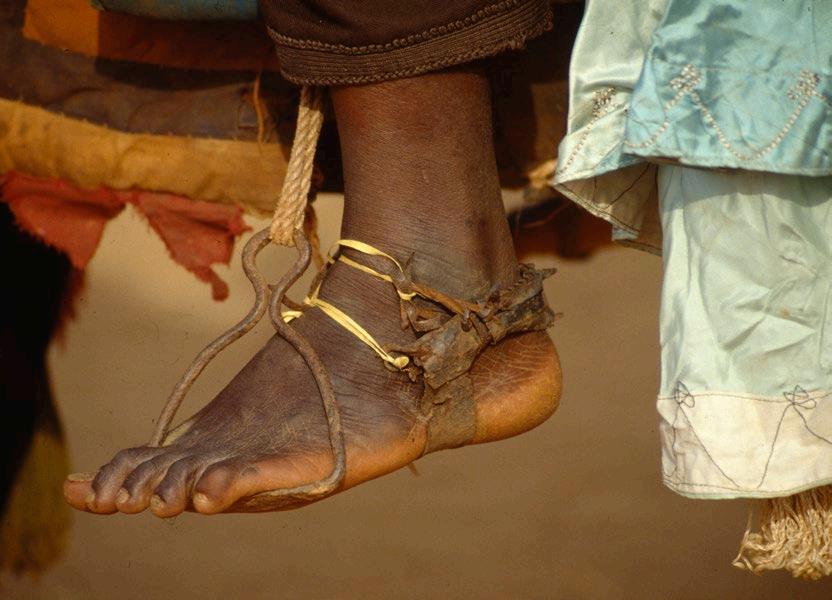
“In riding a horse we borrow freedom.” Helen THomson
The values of Equus Journeys can be encapsulated by a few simple ideas: respect, fellowship, curiosity, exploration, openmindedness, and the importance of the relationship between riders and their horses the world over.
Equus Journeys was created in the United Kingdom as a brand of Cheval d'Aventure, the leading French agency for riding holidays. It was named to evoke everything we stand for: Equus - latin for horse, and Journeys - travel and exploration of beautiful destinations.
At Equus Journeys, we are passionate horse owners and riders with a long and successful history in the horseback riding travel industry. It is our first-hand knowledge that allows us to help you experience the riding holiday of your dreams.
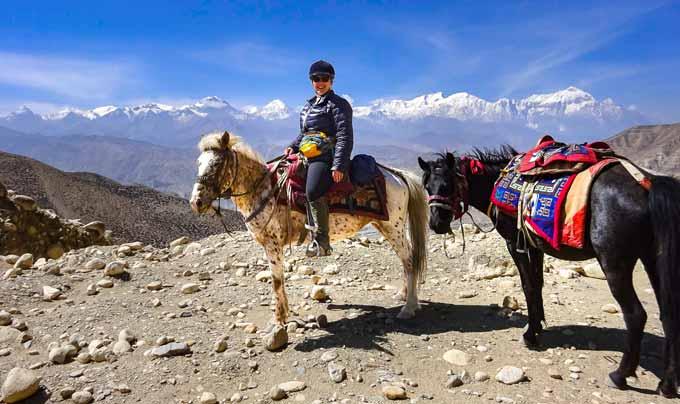
From the Team at Equus Journeys
1
HORSEBACK TRAVEL & TRAILS
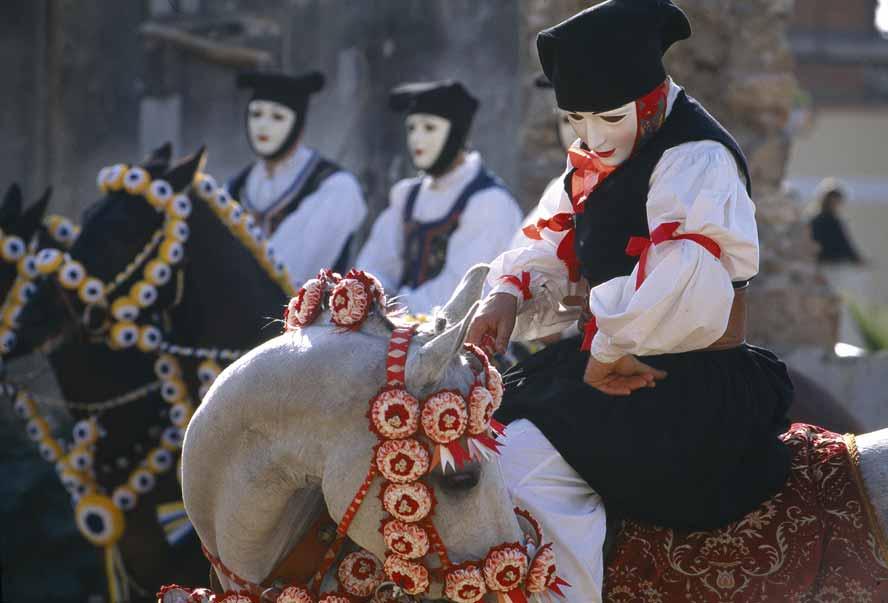
2
Italy - Sardinia traditional carnival celebration.
In England
Correspondence address 14a Forest Gate Pewsham Chippenham Wiltshire SN15 3RS UNITED KINGDOM Tel: +44 (0) 1905 388977 info@equus-journeys.com

www.equus-journeys.com
Meet the Equus Journeys team throughout the year at Badminton, Burghley, Blenheim where we oftenly exhibit.
If you wish to be kept up-to-date with news of our events, new destinations and special journeys, you can subscribe to our email newsletter on our website: www.equus-journeys.com
Our sister company in France
Tel: +33 (0) 4 82 53 99 89 Infos@cheval-daventure.com www.cheval-daventure.com

3
Mongolia - Yurts and horses in the steppe.
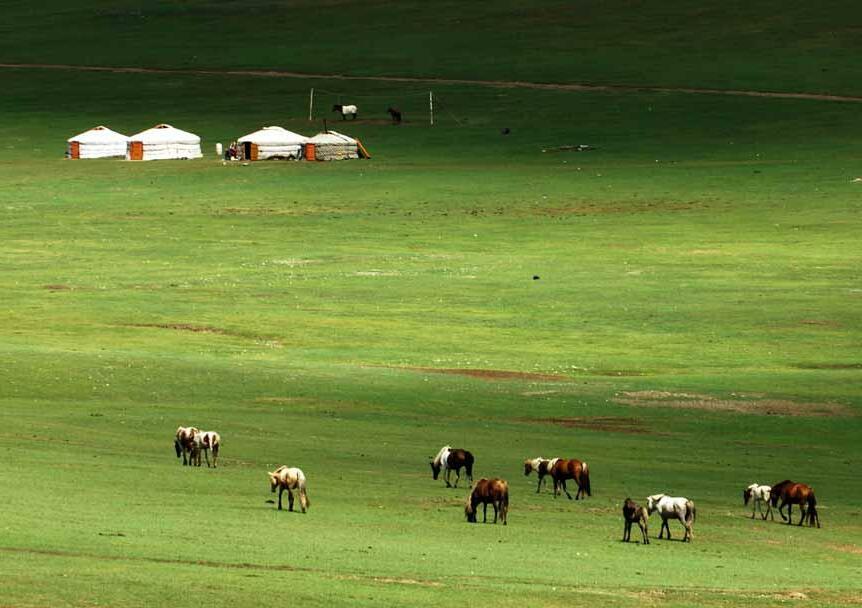
4
Jordan - Horse and hounds in the Wadi Rum desert.
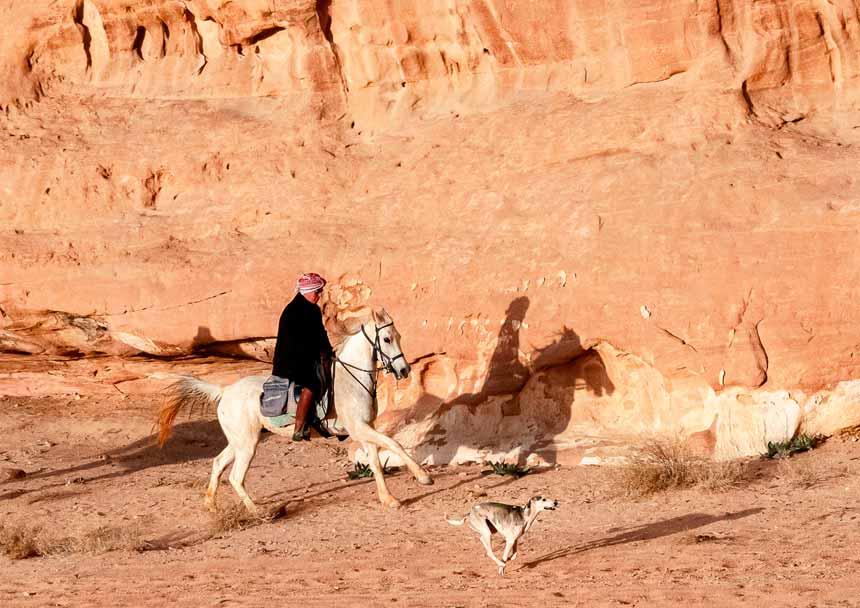
5
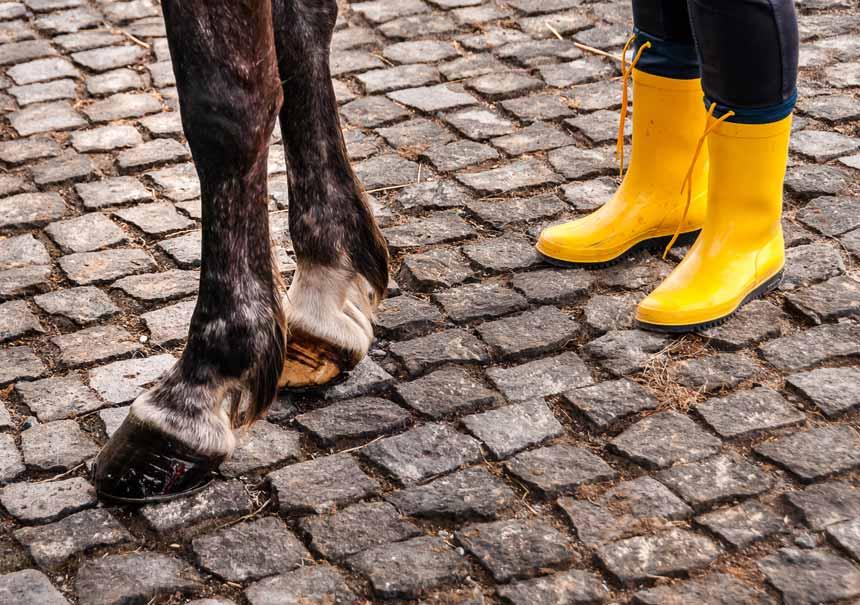
6
Equus Journeys Team
Iris Lapprand Iris@equus-journeys.com
Iris was born and raised in France, but is a true Irish girl at heart! She loves to travel, is passionate about all things horsey and is a keen rider, making Equus Journeys the perfect workplace for her. She has ridden in Morocco, the Azores, Albania, South Africa, Botswana, Jordan, and over several US states. She is always happy to help find the perfect stay for you, your friends and your family and she will go above and beyond to make sure you make memories for a lifetime.
Joanne Verth Joanne@equus-journeys.com
Joanne has worked in the equine travel industry for many years and ridden in India, Botswana, North America, France… and she has traveled far and wide during her life as the wife of an airline pilot! She left the 'cut and thrust' world of advertising behind to follow her dreams and work with horses before joining Equus Journeys. She owns four horses and four dogs and loves meeting new people and learning about their cultures and traditions.
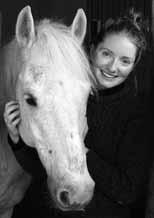
Christophe Leservoisier
christophe@equus-journeys.com
Louise Carelsen louise@equus-journeys.com


Born in the USA, Louise has travelled far and wide and lived in many European countries. Together with her husband Cor, she settled in Botswana where they owned a riding safari business for almost 14 years. They now live in Virginia where Louise works as a rider for racehorses and show horses. She has been on riding trips to Portugal, Zimbabwe, Botswana, South Africa, Ireland, and of course ranch holidays in Wyoming and Colorado.
For almost 30 years, Christophe, a French traveler and rider, has created, guided and organized unusual travel all over the world. The creator of the Ethical Charter of Travelers in 1997 and co-founder of ATR (Responsible Tourism Association), he has always been defending the worth of sustainable tourism. After creating and developing several specialized tour operator companies, he now devotes himself to Equus Journeys, which is centred on his passion for equestrian traditions, nomadic people and Africa.

7

8
Kyrgyzstan - Kyz Kumay, one of the Nomad Games.
Why Book with Equus Journeys?
◗ Specialist horse travel consultants, who have a wide and varied knowledge of the rides and have travelled extensively, including the team members of our sister company Cheval d’Aventure which was created in 1972.
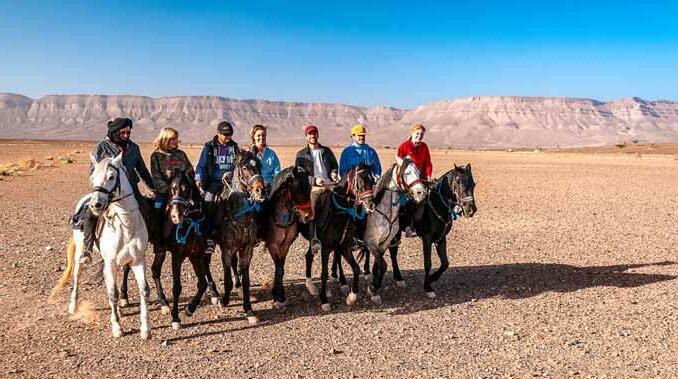
◗ Your holiday is 100% financially protected !
Atradius is the financial guarantor for the entirety of the sums perceived by Equus Journeys.

Hiscox is the civil and professional liability insurer with a guarantee up to €8,000,000.

◗ All holidays cost no more than booking direct. If you see one of the holidays advertised cheaper somewhere else, prices can usually be matched.
◗ All our travel consultants are horse riders and owners who understand what is important to you on your riding holiday
◗ We are contactable on a 24 hour emergency
telephone number so that you can reach us when you are on holiday if you need to.
◗ Completely honest advice -telling you of the possible negative points as well as the highlights.
◗ Holidays and honeymoons can be tailor-made to your requirements.
◗ You can follow your holiday plans on line in your Equus journeys private space including secure online payment facilities.
MoroccoRiding in the Sahara.
9
Equestrian Traditions
Worldwide the horse is revered - ridden, worked, respected and cared for - and riding horses is central to all of our holidays. Equus Journeys believes that it is important to inject local equestrian traditions into the heart of our travels. In each meeting with local horsemen, you will gain insight into the long history of man and horse.
A horse of conquest
Man became a rider, a centaur, when he left for war. In Europe, as elsewhere, riding was born in the battlefields. The Egyptians were maybe the first to demonstrate this, during the famous battle of Qadesh in 1274 BC, where the Egyptian chariots of Ramses II opposed the Hittite chariots.
Two thousand years later, we find equestrian warriors in all corners of the globe. The Samouraï warriors managed feudal Japan for almost 700 years. The riders of Gengis Khan poured into the borders of Europe and destroyed civilizations which were thought superior from a technical point of view. In the 16th century, the expeditions of conquistadors into the New World introduced the horses which were going to
populate America. It was again on horseback that the Bedouins of Arabia started their raids, and more
recently, the Khampas riders who organized the resistance in Oriental Tibet.

10
Benin - Traditional war horse.
Doma Vaquera is the traditional working riding discipline of Spain.
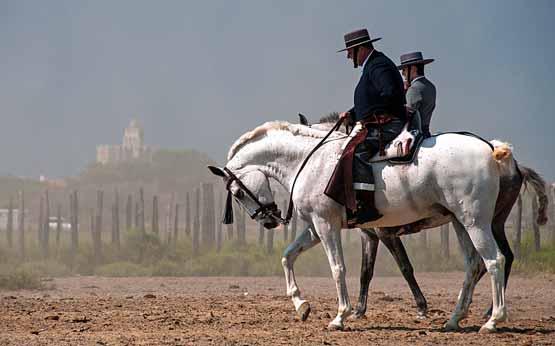
The history of breeds
During the conquests, man transported horses, spread his equestrian technique and created new horse breeds. The most symbolic is perhaps the Barb, which alone has influenced the equestrian world in three continents. Originating in the East, riders from Arabian tribes in the Atlas mountains preferred the local horsesbarbarian or Barb - the breed which brought Hannibal and his armies to the doors of Rome in 218 BC. From Maghreb to western Africa, this war horse became the vehicle of Muslim civilization. Later, after the Arabian conquest of Spain, the Barb horses were crossed with local Spanish
horses to create the Andalusian horse, which, led by the conquistadors into the New World, became the ancestor of the horses which populated America. So, from the Barb blood originates almost all of the breeds of the Americas, from Criollo to Mustang. Another example and a change of scenery: in the 9th century AD in the Northern seas, the long boats (Drakkars) of Vikings sailed to the West, transporting their horses into Iceland. More than a thousand years of isolation have preserved this special breed which has two unique paces - the tölt and the
flying pace, which have been lost by other breeds. Another curiosity of equine history are the stories of horses introduced by conquerors and then abandoned in the wild. We have all heard of the American mustang, but less well-known are the forgotten horses of the Namib desert which were left behind by the army during the great wars of 1914. These horses adapted to survive in the desert and their genes changed progressively over several years. Today they are a smaller, unique and hardy horse.
11
Mongolia - Gobi Steppes.
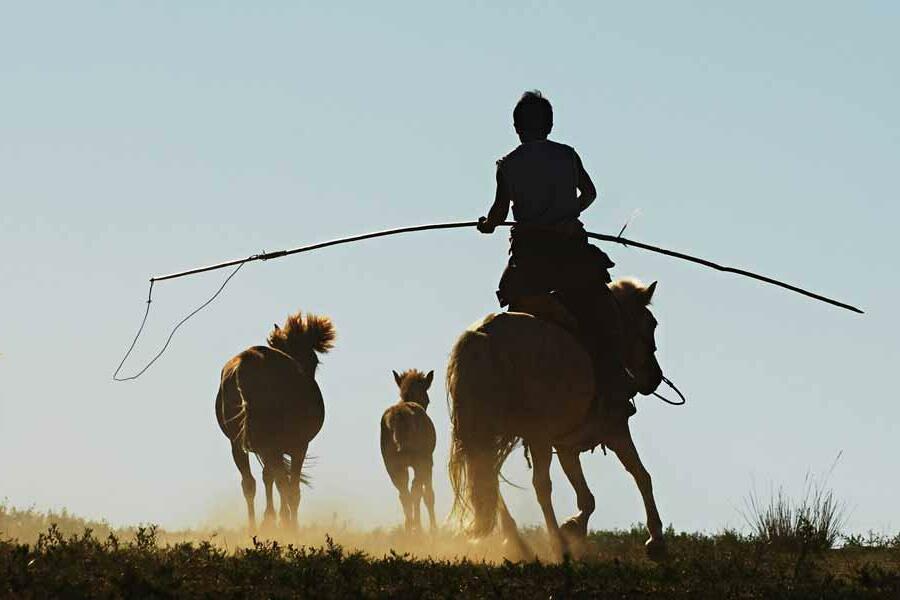
12
Namibia - Flying across the Namib desert.
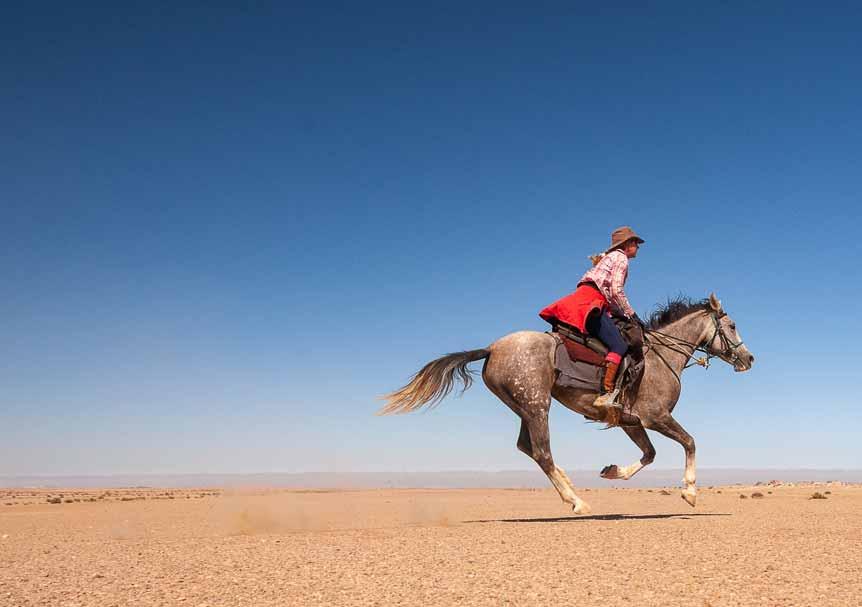
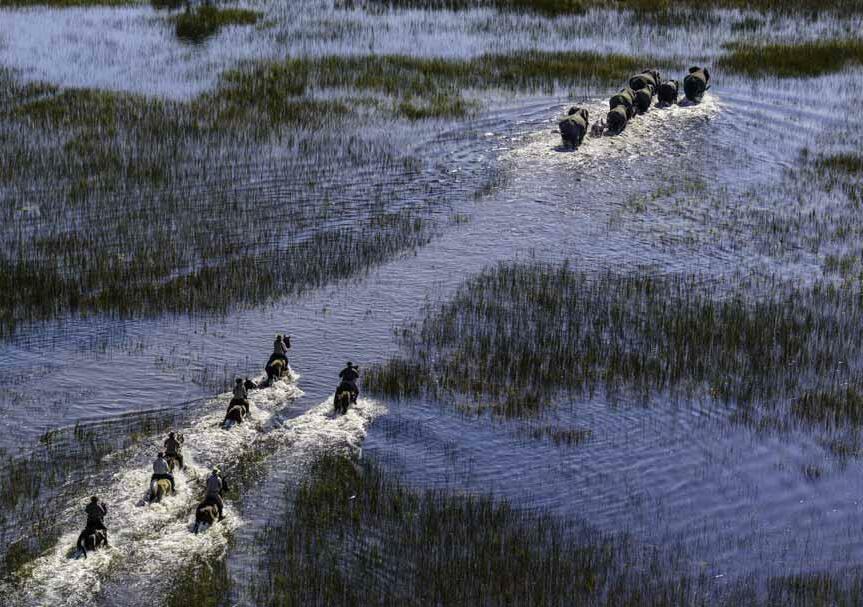
13
Rider equipment
Boots:
For the majority of situations: light hybrid riding/hiking boots with a decent sole and heel, worn with short chaps. Dressage lessons: short boots with chaps (or long boots if you prefer).
Horseback safari: light hybrid riding/hiking boots with short chaps. Long boots can get very hot. Full chaps can be useful because they protect from thorns. Don’t take your best leather boots as they could be damaged. If visiting the Okavango Delta during high flood waters then it may be worth taking two pairs.
Ranches and cattle drives: short boots with chaps or cowboy boots.
Environment:
If travelling in remote locations, then take a pocket torch with a dynamo which doesn’t require batteries, choose biologically friendly liquid soap for washing in rivers and take a hybrid solar charger for charging your batteries.
Hard Hat:
We always recommend that you take your own hard hat to ensure a good fit. On some rides hard hats are compulsory. Nowadays there are many manufacturers of lightweight helmets, such as Troxel, which are ventilated and more comfortable in hot climates. There are also products available which fit over your helmet to make them look more like Western hats or to provide a brim for shade.
Rainwear:
Can be essential dependent on your destination. Waterproof over trousers and jackets such as Barbour or Goretex protect against persistent rain. Avoid ponchos or flapping capes as they do not protect well and can frighten the horses. Always dismount your horse when adding waterproof layers.
Trousers:
Whatever you usually ride in and are most comfortable in - make sure you have worn them before travelling so you know they don’t rub. Breeches, jodhpurs or a pair of jeans (without inside seams) are the most common. On ranches your guides will likely wear jeans or thick canvas trousers.
Saddle bags:
Are often, but not always provided for you - they are fixed behind or in front of the saddle and allow you to bring small items with you, such as water bottles and suncream. If you need to buy your own then choose flexible materials which are light and waterproof, but bear in mind that not all horses are happy to carry one. Leather or nylon laces are a cheap alternative for tying extra layers/jackets to the back of your saddle.
14
Top ten tips for good photographs
◗ The best pictures are taken on foot! With the agreement of the guide, ride ahead of the group, dismount your horse, choose the sport mode and take photos of the group approaching you.
◗ For pictures taken on horseback, try to ride slightly to one side of the group, keep hold of your reins and talk to your horse.
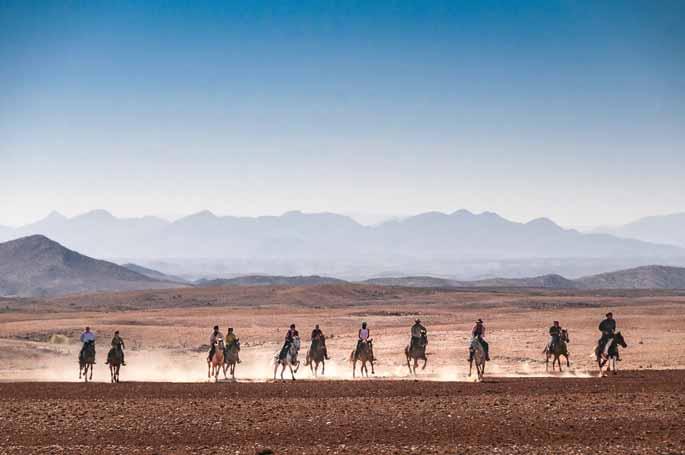
◗ Take pictures of the horses and their riders in motion. Focus on a section of the group - odd numbers of riders seems to work well.
◗ To frame your subject well, move him out of the centre and respect the proportion of 1/3 sky, 2/3 earth or vice versa, and ensure there is something of interest in all four corners of the picture.
◗ Use the automatic mode because horses rarely stay still for long adjustments!
◗ Early morning light or late afternoon light is preferred.
◗
Favour a compact camera which has a built-in stabilizer and UV protection filter. Bulky cameras are not sensible on horseback.
◗ Take enough spare batteries with you and save your battery life by avoiding using the screen and not letting the batteries get cold.
◗ Protect your camera from dust, bad weather and falls by keeping it in your jacket, bumbag or in a bag attached to your belt and put the lanyard over your head.
◗ Ask the consent of people you meet on the trail before taking their photographs.
15
Namibia - The wide open spaces of the Namib.
Extracts from the Ethical Charter for riders
These extracts are part of the equestrian extension from the Ethical Charter of the Traveller in relation to respect, nature, men and horses. We invite you to read it before your holiday.
Respect is the basis of a better experience
•Striking up a conversation with a pedestrian whilst you are mounted could be interpreted as a sign of su periority over the walker. Dismount, stay between your horse and the person you are talking to - your conversation and the qua lity of your meeting will then be on an equal foo ting.
•Watering places are pre cious and essential to hu man, animal and farming life. Ask permission before letting horses drink from wells and do not soil the water and the surrounding area.
•Equestrian cultures are va ried and all are good if they are done right. The urge to discover, your hu mility and respect are a re flection of your curiosity.
The horse - the heart of your travel
•In ethology, anthropomorphism signi fies the projection of human motivations and feelings onto an animal. Avoid this practice with your horse and treat him with humility and respect.
•Letting your horse trot to catch up whenever it pleases him is a bad habit which is very hard to cor rect. All horses should be able to walk on at a decent pace.
•Local guides, who know their horses, are the best placed to advise you on girthing, adjusting the tack, drinking, tethering etc.
Between riders…
•Whilst riding, we have to remember to respect the other horses and riders who share our ride and perpetuate the tradition of good manners. We should always be conscious of our actions.
•We advise you to always wear a hard hat/helmet, even if your guides and other riders do not wear one - it is your head! There are many lightweight, ven tilated helmets available nowadays.
•Be courteous to your fel low riders - point out possi ble dangers such as holes and low branches, and pass back messages from the guide.
Complete version on www.equus-journeys.com
16
Estancia Los Potreros in ArgentiaAngel bit, by Astrid Harrisson.
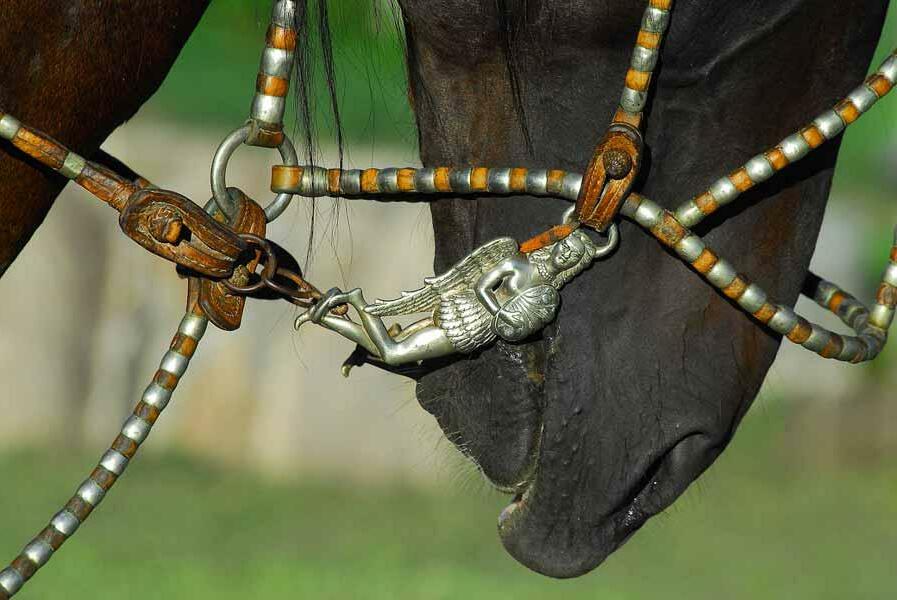
17
Finally completely free, connected only to the earth and sky, all senses are stimulated for a complete immersion in his powerful and generous nature. I made a pact with my horse, actor and accomplice, he guides me to an unknown world and to real meetings; each day I become a little more, a piece of the Universe. I am a nomad, my expedition companions are my family, the camp fire brings us together, time does not exist anymore.
Anne Mariage, founder of Cheval d’Aventure

18
Ecuador - Riding across the Ecuadorian paramo.
Real horseback adventures and journeys! Long trail rides where your belongings are often transported by pack animals enable you to reach isolated areas, forgotten high valleys and meet local people and learn about their traditions.
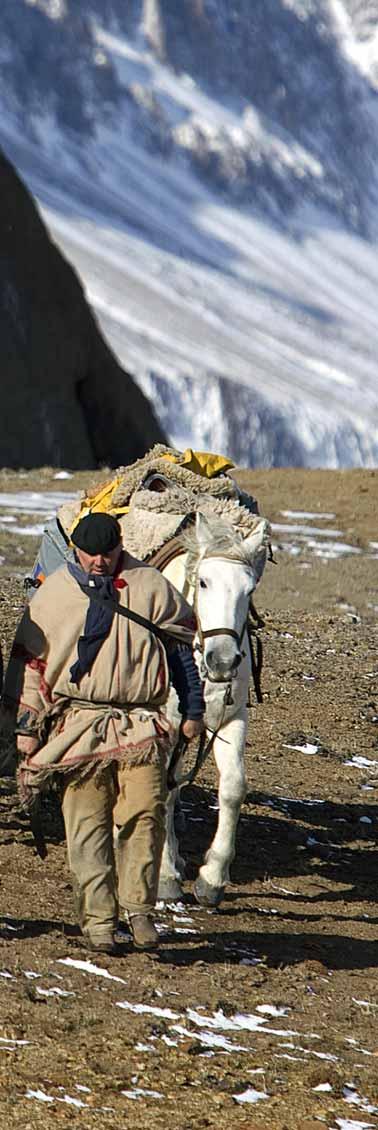
Expeditions & pack trips
19
Read more…

“Canada's westernmost territory and last frontier before Alaska. Glacial valleys, volcanoes, rivers and lakes, forest and toundra... An extraordinary journey for adventurous riders, far from the beaten path.”
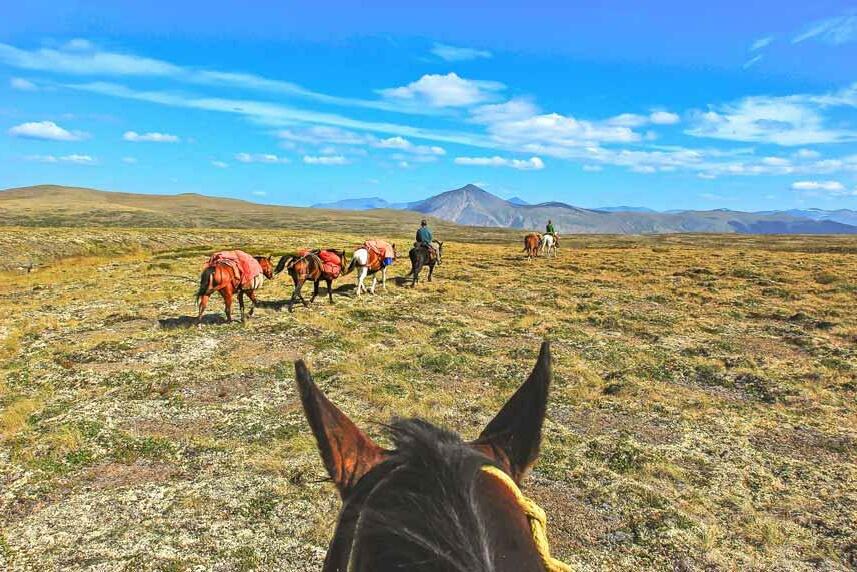
20
Canada Yukon, Ibex Moutains.
Travel spirit
“The history of our sister company, Cheval d’Aventure, is linked to the pack trip. Since 1972, the soul of Cheval d’Aventure has carried on thanks to bold and curious riders all over the world, who have opened and guided new trails which are more accessible on horseback than in a vehicle.
Mountains, high plateaus, snowy passes, isolated valleys, high altitude lakes and rivers… Life can be hard in these environments in which you will ride, but the inhabitants are warm hearted.”
To join an equestrian pack trip requires an open mind and to be physically fit because it is often necessary to walk on foot, leading your horse on steep paths. The riding experience required is intermediate because the principal pace is walk, however you do need to be balanced in the saddle. You also need experience of handling horses as you are usually required to prepare your own horse each day - grooming, tacking up etc.
Accommodation is basic as you have to carry everything with you: luggage, tents, cooking
facilities and supplies. Most expeditions use pack animals such as horses, yaks or camels; occasionally a vehicle.
Lunchtime picnics are carried in saddle bags; the campsites and tents are simple; the washing facilities are in the river and the participation of all is required around camp. A pack trip is a true initiation into the world of riding expeditions and those with previous experience of trail riding will find the transition easier.
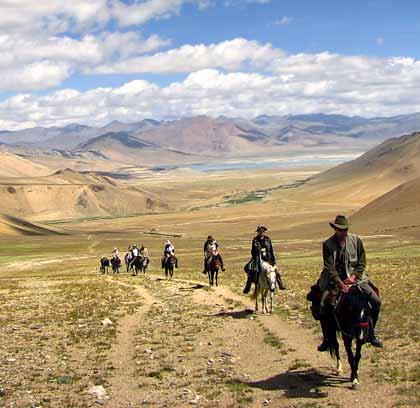 India - Ladakh, Little Tibet.
India - Ladakh, Little Tibet.
21
Read more…

“A unique opportunity to discover South America under a different light, experiencing the gaucho way-of-life and riding across the virgin steppe, endless pampas, and the Valdivian rain forests of Chile.”
Chile - Argentina, Andes Grande Traverse.

22
Did you know
The Long Riders Guild is an international association of equestrian explorers. The invitation-only organisation was formed in 1994 to represent riders from all nations who have ridden more than 1,000 continuous miles on a single equestrian journey. With members in forty-five countries, every major equestrian explorer alive today belongs to the guild, including Hadji Shamsuddin of Afghanistan who rode a thousand miles through the war-zone and Claudia Gottet of Switzerland who rode 8,000 miles from Arabia to the Alps. Their website www.thelongridersguild.com is full of stories, legends and knowledge.
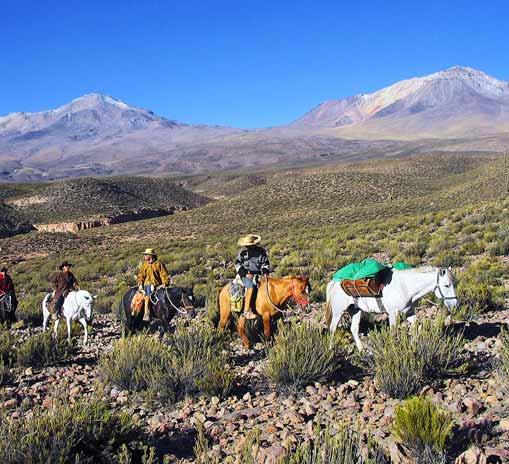
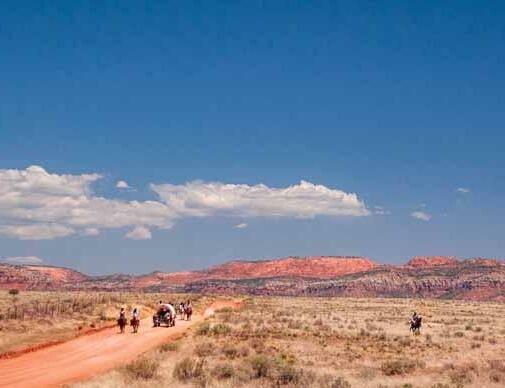
23
Chile - Atacama Desert.
United States - “Three Park Spectacular” ride across Utah & Arizona.
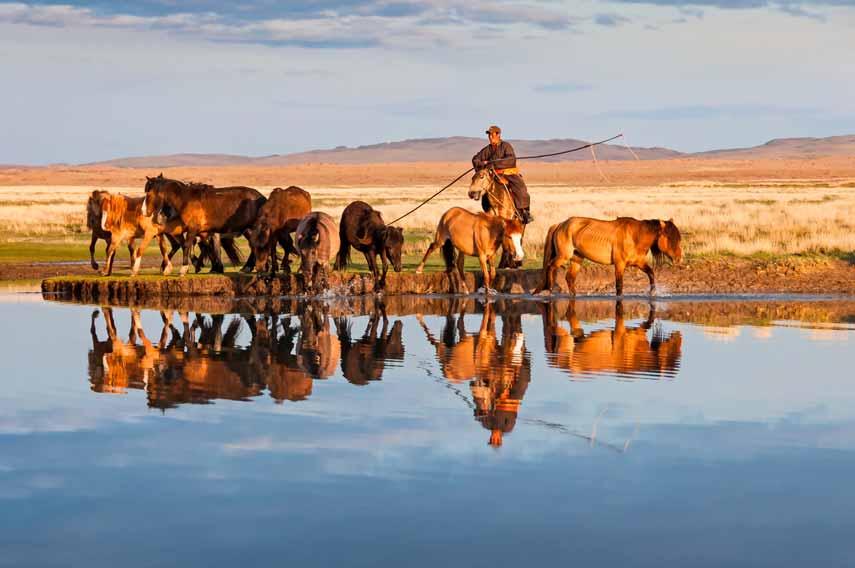
24
Mongolia - The Gobi desert steppe.
Horses
The horses ridden during an expedition trip are born in the areas crossed and are adapted to their environment. They belong to our local teams and have been selected for their robustness and toughness. They are surefooted and can carry you safely down dizzyingly high paths. Their mentality is excellent - even though their training is not to the standards you may be used to, they are careful over tricky terrain. Your belongings are usually transferred by pack-saddle on
either yaks, mules, camels or horses - sometimes a vehicle may provide the expedition with fresh supplies. The pack animals may travel with you, but often they go by a different route with the camp team and chef so that camp is settled before you arrive.
The saddlery is very local too although it has been improved to provide comfort for long hours in the saddle: western saddles, local English-type saddles, Cossack saddles or cavalry saddles.
Some breeds:
The Mongolian Horse is a small horse, standing between 1.22 m and 1.42 m (12hh - 14hh), compact and very strong. He possesses a resistance to inclement weather conditions because he was born in the open, with an aptitude to grow fat quickly during the short summers in order to survive the long, cold winters.
The Qarabair is a Tadjik horse which is fit and spirited, of
medium size and well-known for its toughness and tenacity.
The Kyrgyz Horse is a crossbreed of “celestial horses” which received much praise in ancient texts, and is a mixture of different Russian breeds with the Thoroughbred. This breed of horse, which contributed to the Kyrgyz identity, was almost an endangered species, but the obstinacy of one of our guides, Jacqueline Ripart, assisted its rehabilitation.
Did you know
Among the equestrian games of Kyrgyzstan, the Kyz-kumaï “Catch the girl”, matches the fair sex and the male sex in an attempt to flirt: the boy chases the young girl on horseback to try to kiss her. If she wins, then on her turn, she chases him to try and hit him with her whip!
25
Read more…

“A unique chance to be involved in the equestrian Tagong festival amongst the Tibetan highlands, where Khampas horsemen dress in their finery to race...”
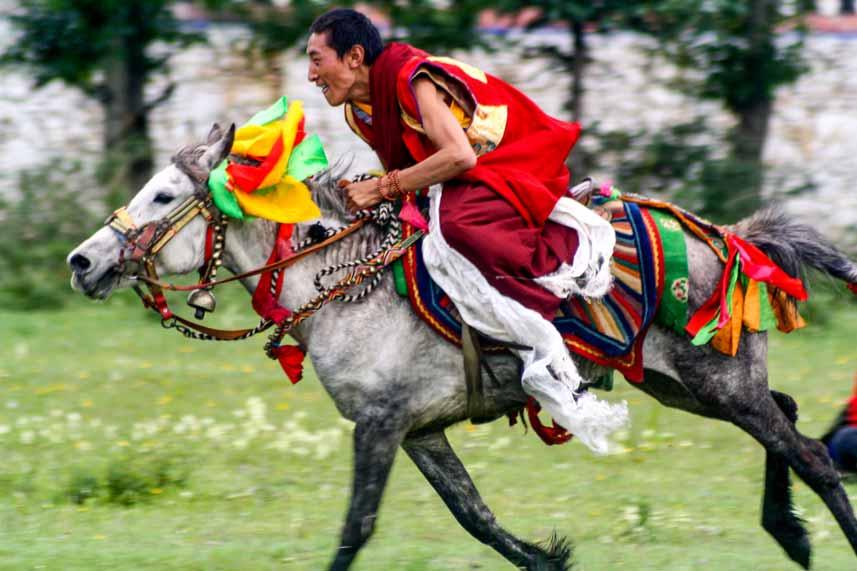
26
China - Tagong Festival, in the heart of Kham in eastern Tibet.
The Abyssin Pony, is thought to have derived from different crossbreeds with a mixture of Arabian or Barb horses. He is distinguished by his thick coat, dishevelled mane and incredible resistance.
The Tibetan Horse of Khampas is small, energetic and tough, perfectly adapted to the altitude and to difficult terrain.
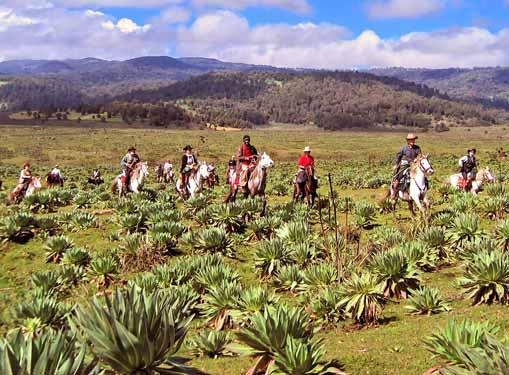
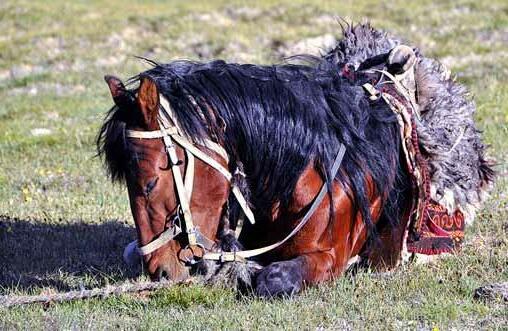
Did you know
In 138 BC Chang Ch’ien journeyed for 13 years through Central Asia and was particularly impressed with the fine horses of Kokand which sweated blood - he named them
Celestial Horses and bred them as war horses for their size, stamina and strength. Celestial horses became status symbols for rich men and officials and were immortalised as bronze statues. The phenomenon of "sweating blood" was actually caused by a parasite which burrowed under the skin in the back and shoulders of the horse, which caused little swellings which burst and bled.
27
Tadzhikistan - Horse at rest.
Ethiopia - Horseback trail across the Bale Mountains.
His hoof knocks a stone, creating glittering sparks. His powerful quarters hoist us along the mountain path which smells of herbs. Flat on his neck, wet with sweat and with long reins, I bury my head in his mane to avoid the dry branches which whip us as we pass. Our guide tells us we are at the top… almost. The path ends. The panorama is huge. The blue water shines in the distance and the breeze brings with it the fragrance of the sea. A tortured pine shares its shadow with us, for the most beautiful picnic lunch in front of an endless vista.
Rider feelings.
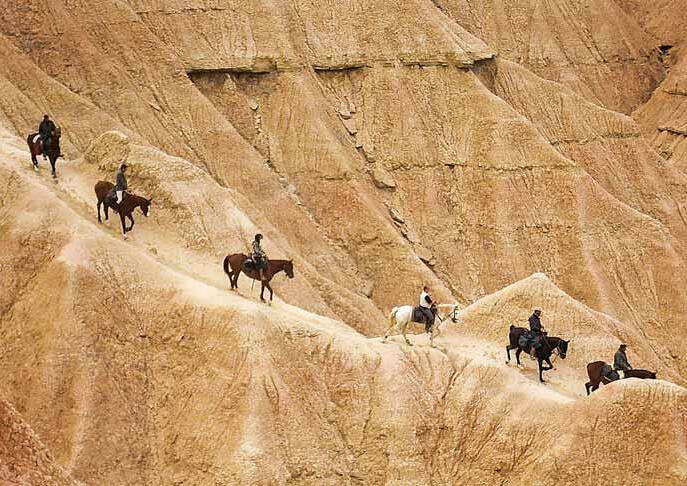
28
Spain - Bardenas.
A mobile trail ride where you move on every day. Depending on the type of journey you prefer, you could spend your nights camping or in comfortable accommodation.
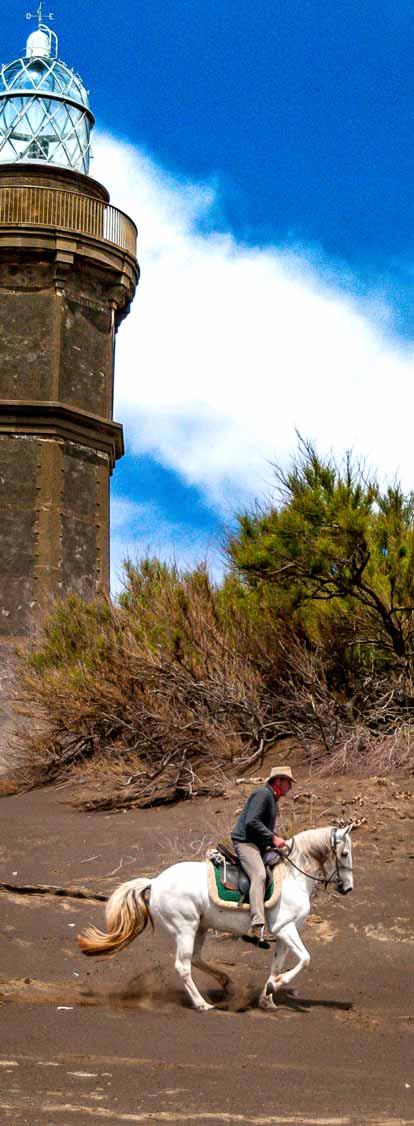
29 Trails
Read more…

“An adventurous camping experience in the pure tradition of the Old, Wild West. Pariah River Canyon, Bryce Canyon and Zion National Park, & Toroweap within the Grand Canyon National Park. “Spectacular” almost comes as an understatement!”
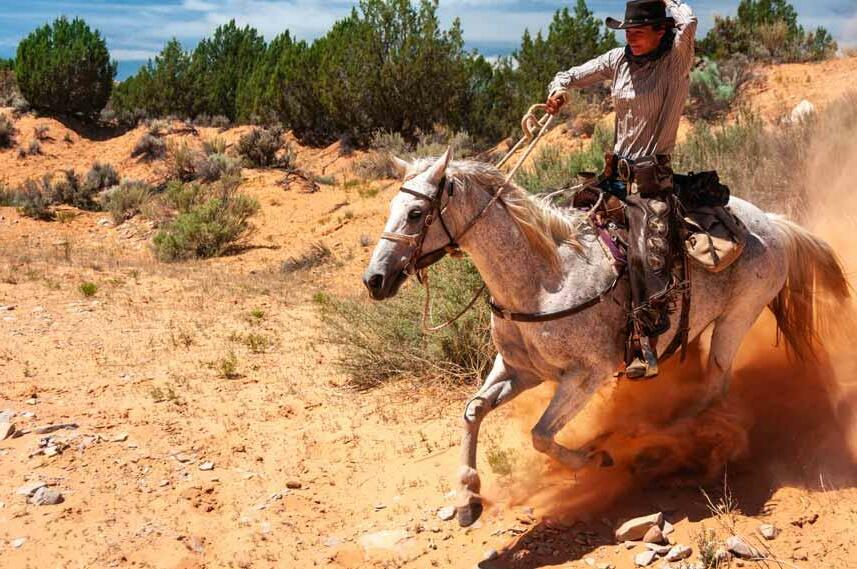
30
United States - Bringing out your inner cowgirl in Utah!
Horseback trails
Going on a trail is to leave behind the indoor arena and the outdoor school, and to follow a path for a mobile route of several days. To immerse yourself in the rhythm of a trail, whilst at the same time remaining reasonable, the ideal stay is somewhere between 5 and 15 days on horseback… but there is no true limit! The accommodation on a trail ride generally changes every night and there are trails to suit all tastes: wild camping or charming guesthouses. Each morning, the luggage is loaded onto a vehicle and taken to the next stop. Only what you require for the day (water bottle,
rainwear) finds a place in your saddle bag. You travel light so as not to clutter up your mountremember that it is he who will travel the 20-45 km each day. For this reason, the pace is often walking, but when the ground permits it, you should expect long trots and wonderful canters!
Depending on the country and its equestrian traditions, you may be expected to take care of your horse during the trail.
A riding hat/helmet is always compulsory for the under 18’s and we strongly recommend them for all, even if your guide doesn’t wear one.
France - Horseback trails & pack trips in the rugged beauty of the Pyrenees.

31
Read more…

“On fit and forward Arabian horses, we are allowed the pleasure of long stretches of active riding... Finding our way in the welcome coolness of shaded canyons, galloping across endless plateaus, discovering wondrous landscapes...Trail riding in Cappadocia is an experience that will stay with me forever.”
Turkey - Wonders of Cappadocia... Galloping across the Rose Valley.

32
Italy - Swimming with horses in Tuscany.
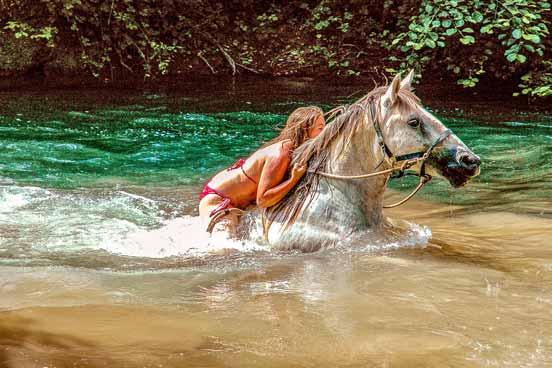
Did you know
In Iceland, where the horses do not measure over 14.2hh, it is customary for the riders to change horses 2-3 times each day. As your riding group is likely to consist of 14 to 20 riders, you could be following a herd of 50 to 60 loose horses! A show in itself! Regular stops are planned to change horses and therefore the pace can remain fairly steady throughout.

33
Iceland - Rush hour in Landmannalaugar.
Portugal - Equestrian traditions & Portuguese horses.
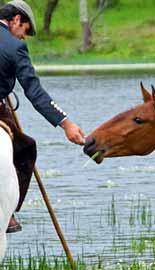
A multipurpose horse
A good trail horse is not simply a “nice and easy” horse. He has to combine numerous qualities: be calm and serene, but with an energetic walk; he should be used to all the surprises which can occur on the path, either natural or manmade (tractors, bikes, deer etc). Used to being ridden within a group, he is generally sociable and should listen to his rider. Finally, the trail horse is an overall good athlete, with a sure foot and a strong constitution, capable of walking for several hours on difficult ground, to sleep tethered to a line and to tolerate all weathers. In order to satisfy all these requirements a lot of the guides will breed their own horses, using their best trail horses. Some of these “field cocktails” do not look very special but they can turn out to be generous companions.
Local breeds, long adapted to the climate and ground are a very good option for the trail. Like the incredible Icelandic Horse who lives outdoors in a herd all year round. The local mounts offer the gift of a unique equestrian experience on a horse which often has an atypical morphology: small, stocky Merens raised in the Pyrenees; the nice Finnish horse, round and hairy; the fit Marwari of Rajasthan with his high head carriage and curved ears.
On the whole, the horses which have been carefully selected to be effective “work tools” are also excellent mounts for trail riding. Depending on the destination, you frequently find Quarter-horse, Criollo, Camargue and Andalucian horse crosses. The Arabian, and its numerous crossings, is also very popular and known for being physically tough.
34
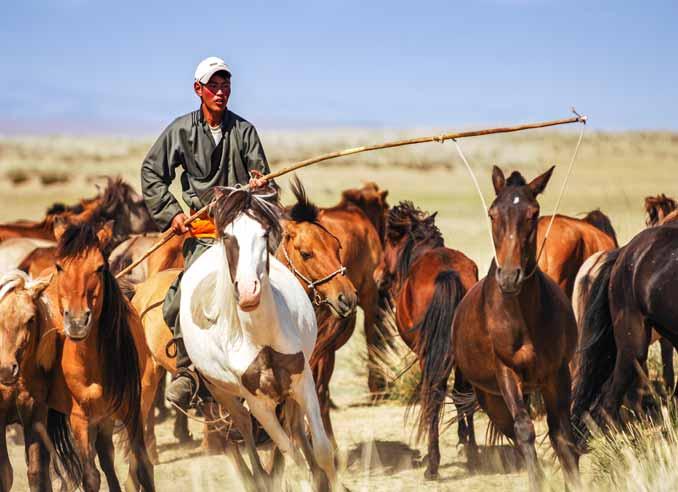
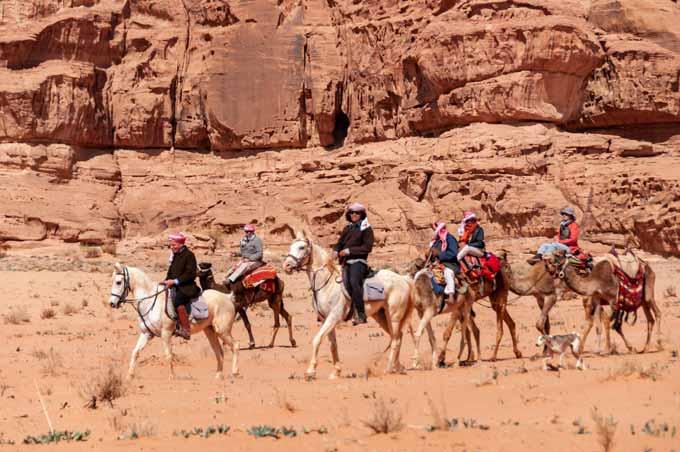
35
Mongolia - Catching a horse with the traditional “uurga”.
Jordan - Deep into the Wadi Rum desert, for riders... and non-riders!
Did you know

The Icelandic horse is a part of the history and saga of the country and its Vikings. It is characterised by its extra pace - the tölt, which is fast and very comfortable. Some are also capable of an additional Flying Pace, which is similar to trot, but much faster and used for racing. On a trail riding holiday in Iceland you will likely ride with a group of loose horses and change mounts once to twice a day, to preserve the horses' strength.
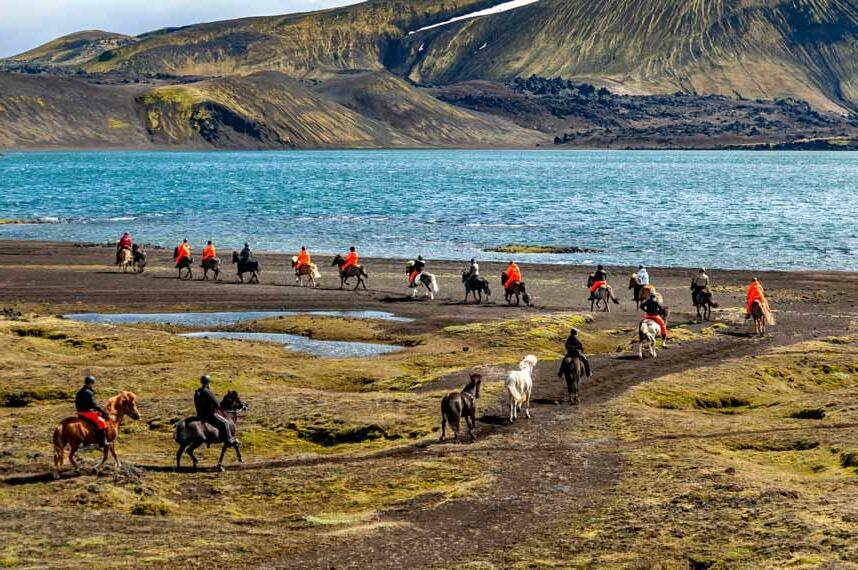
36
Iceland - Trail riding in Landmannalaugar.
Morocco - Riding across the sand dunes of the Sahara desert.

37
Choosing the right trail
The right choice of horseback trail depends on numerous parameters, such as atmosphere and landscape, duration, time of year, budget, accommodation and riding ability. Here are some important points you should take into account:
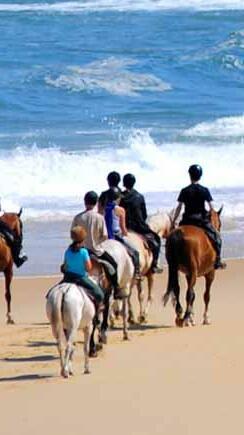
• It is better to join a trail which is suited to your riding level. Knowing how to evaluate yourself can be difficult, but making a mistake can ruin your holiday… and that of your trail companions! Ask yourself the following questions: what is your riding level? What are your trail experiences? Do you ride regularly, and if not, do you have the possibility to ride several times before your departure? The staff at Equus Journeys are happy to discuss all this with you to find you a trail that suits you.
• Camping or rustic huts permit you to make the most of the wilderness, to travel on remote paths and see remarkable sunsets. But a good bed and a hot shower can help you to recover from the tiredness of the day and so
a camping trip may not suit you. A horseback trail can also be a luxurious experience, with exceptional accommodation and grand meals. Be sure to tell us of your wishes!
• The pace of trail rides varies considerably depending on the horses and the ground. If you want energetic gallops, choose trails on soft, flat, open ground with lively horses. Conversely, mountainous itineraries offer spectacular views, but slower rides over uneven ground, which requires a good horse.
• Mountain Trails often require you to dismount and walk on foot during steep climbs or descents. You have to be physically fit and wear appropriate shoes!
38
France - Aquitaine, Atlantic rides.
Did you know
Chagras clothing
The poncho is believed to have originated in Castille and was taken to South America by the early explorers- it keeps riders both warm and dry. The traditional over-trousers are made from the skins of goats, lambs, bear, wolf or deer and are often worn with the furry side outermost rather than inside. The chagras lasso is formed from twisted leather and is the worlds longest, measuring 25 - 45m. The wooden stirrups protect the feet from when riding along rocky paths.
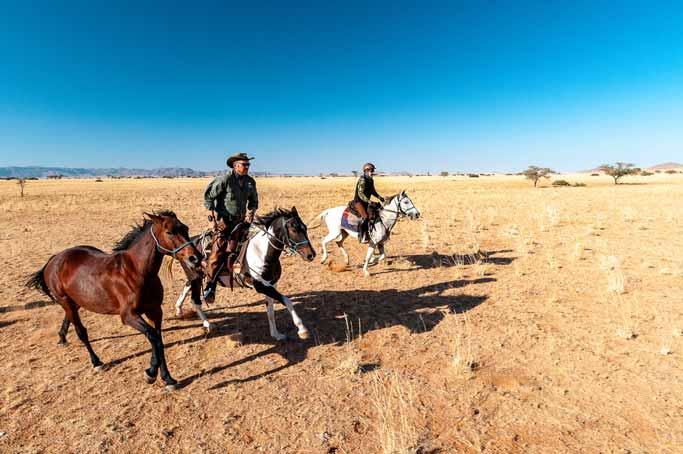
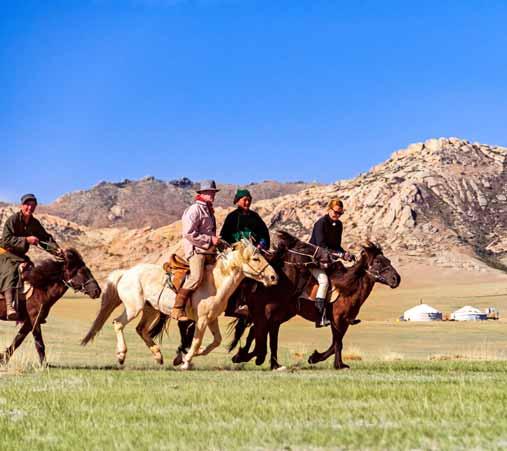
39
Mongolia - The Gobi desert.
Namibia - Crossing the Namib desert.

40
Iceland - Landmannalaugar and its unique atmospheric scenery.
France - Riding across the Mont Saint-Michel bay in Normandy.
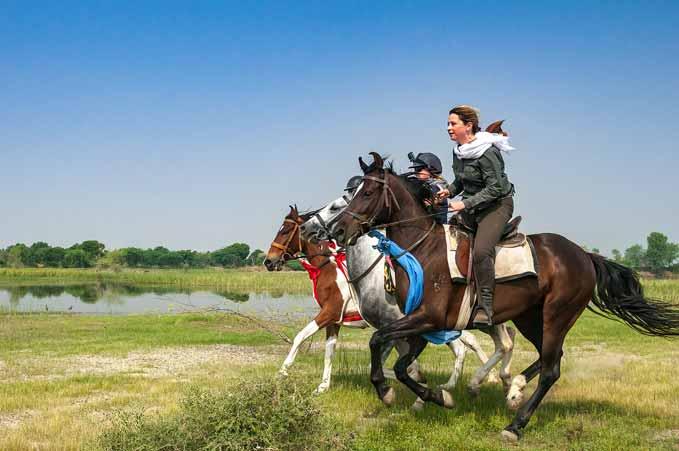

Did you know The fair of Pushkar
During the month of Kartika, the lunar eighth month of the Hindu calendar, breeders throughout the whole of Rajasthan bring their horses and camels to Pushkar for the kartik purima (the full moon). Each year some 200,000 people converge here, bringing 50,000 camels and horses. The city is transformed into a whirlwind of sound and colours.
41
India - Riding Marwaris in Rajasthan.
How quickly our children learnt how to fly a kite or kick a football, to fetch water, play cards, milk cows, shear or sort sheep and wrestle. And the teenagers are initiated into handling the “uurga” on horseback (leather lasso on the end of a 4 metre pole, used for catching horses), learning to respect their mounts, to round-up the horses early in the morning… and the Mongolian children have learnt how to cheat at cards as well as our own children do! After a football game, a horse ride and lots of laughter, we shared the wind of freedom. In Mongolia the sky is huge everywhere.
Two families in Mongolia
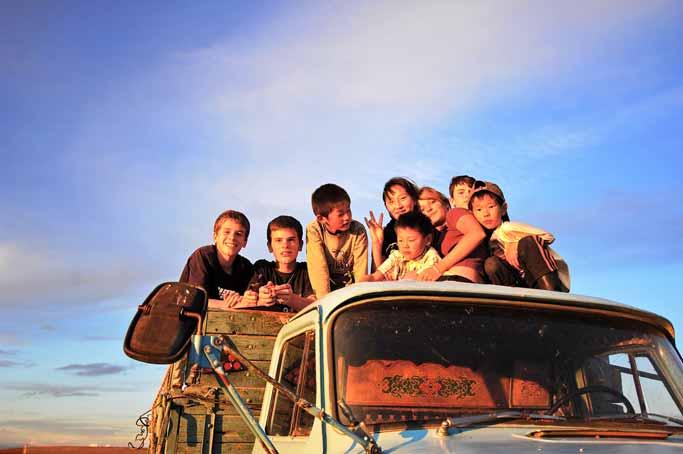
42
A selection of the most beautiful horseback rides to suit families. The pace of the riding, the accommodation and guiding are adapted to include children and nonriders are welcome.

Families
43
On the blog…

“A branding day is not just about smoking irons and bloody scalpels. It is a big event in the life of the ranch, with guests, ranchers and neighbours all coming together for the occasion. The whole thing has an amazingly festive feel to it...”
United States, MontanaA group of “outlaws” put to work at a working cattle ranch!

44
Travelling with families
Sharing the passion of horses and travelling with your family can be a headache, particularly if not all the family are riders. However, we have solutions to this problem!
The best solution is a holiday in a place which is dedicated to riding: a ranch, guest house or equestrian home which offers active, fun and culturally interesting alternatives. Centre based stays are more easily able to adjust to families with young children. Mobile trail rides are better suited to older children, and some are also accessible to nonriders if it is possible to travel some sections on a camel, walking or on mountain bikes.
An equestrian family trip also offers the opportunity for nonriders to learn or to improve. A young rider will always be proud of her father if he has a go at riding on holiday and will be delighted to offer him some advice!
Riding holidays can also be popular for a mother and her daughter (s) or a father and his sons… and if their equestrian ability is sufficient, then most of our rides become accessible.

Holidaying with several families creates friendships between groups of children, each age group becoming independent from the other.
Did you know
Greek Gods and horses
Throughout Greek mythology, the horse was a pre-requisite for the hero and the gods.
Remember the centaur?
Pegasus, the horse of Troy, the carnivorous mare of Diomede, the mounts of Hermes and Helios… The horse - rare, noble warrior and companion, represented wealth and prosperity.
France - Smiles all around on our trail ride to Mont-SaintMichel.
45

46
France - Normandy, family ride in the Mont-Saint-Michel bay.
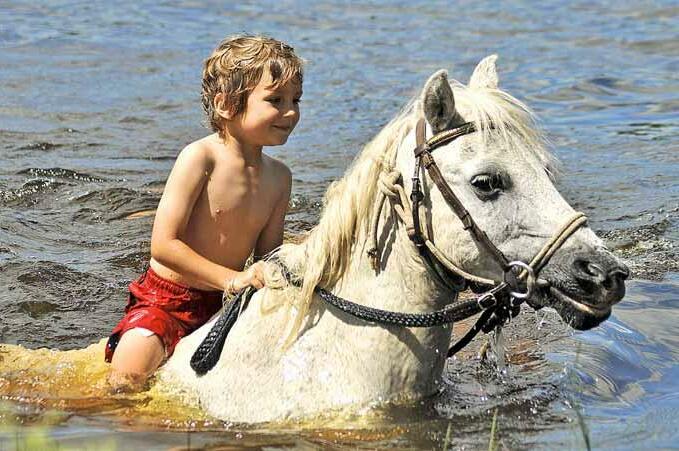

47
South Africa - Waterberg. Mongolia - In the Gobi, learning about the nomadic lifestyle & traditions...!
Riding hats/helmets are compulsory for all riders under 18. We recommend all riders wear a correctly fitted hard hat and take their own with them.
Horses for families
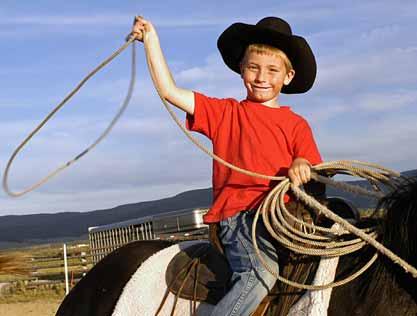
The horses offered for family riding groups have to be very multi-purpose. Just as the age, weight, size and equestrian level of the riders are different, so are the horses. Mongolia and Iceland are the exception because these countries have only one breed available: the Mongolian Horse and the Icelandic Horse, but both are small. Beyond the breeds, even the size, disposition and temperament of the horses have to be suitable for different abilities. The qualities required in a horse suitable for children are kindness, softness, surefootedness and gentleness as well as being safe, energetic and patient for games on horseback.
The breeds
Haflinger: coming from Tyrol (the Hafling village), the Haflinger, named Avelignese in Italy, is a mountainous breed which is small and light and used under saddle and as a draft horse. This small horse is robust, solid and endowed with a calm and pleasant nature and a docile and affectionate temperament. The Haflinger is easy to identify with its chestnut coat and flaxen mane.
The Welsh pony: the Welsh Mountain pony is one of the oldest Welsh breeds and we can find evidence of it during the time when the Romans were present in Wales. In the 16th century, Henri VIII ordered his subjects to shoot all mares which were less than 13hh; a group of ponies took refuge in the Welsh mountains, where the ground, climate and influence of Arabian blood created the Welsh Mountain pony. Its intelligence combined with its natural kindness make it a pony which is fantastic for children. He is very surefooted and popular on trails.
48
Usa - Montana.
South AfricaWaterberg plateau.
Did you know Airag
Even today, Mongolians traditionally use mares milk, which is essential to their nomadic lifestyle. It is possible for them to obtain 150 to 300 litres of milk per year, in addition to what the foal drinks! This represents an average of 3 to 4 litres per day which is collected during an average of five daily milking sessions. This mares milk is also used to prepare the traditional fermented milk called “airag” or “kumis”.
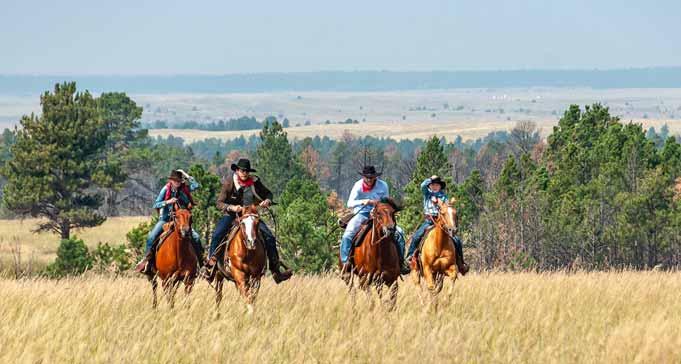
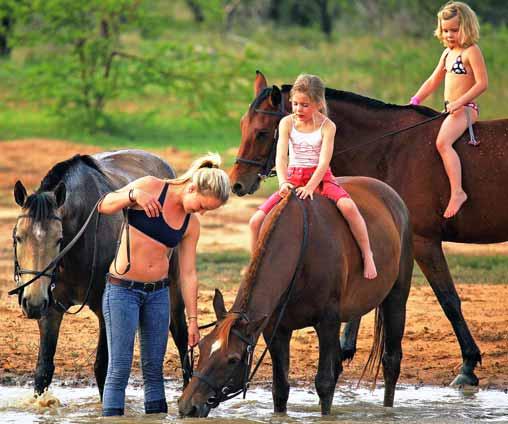
49
United States - A friendly race between siblings.
Italy - Family riding lessons in Tuscany.

50
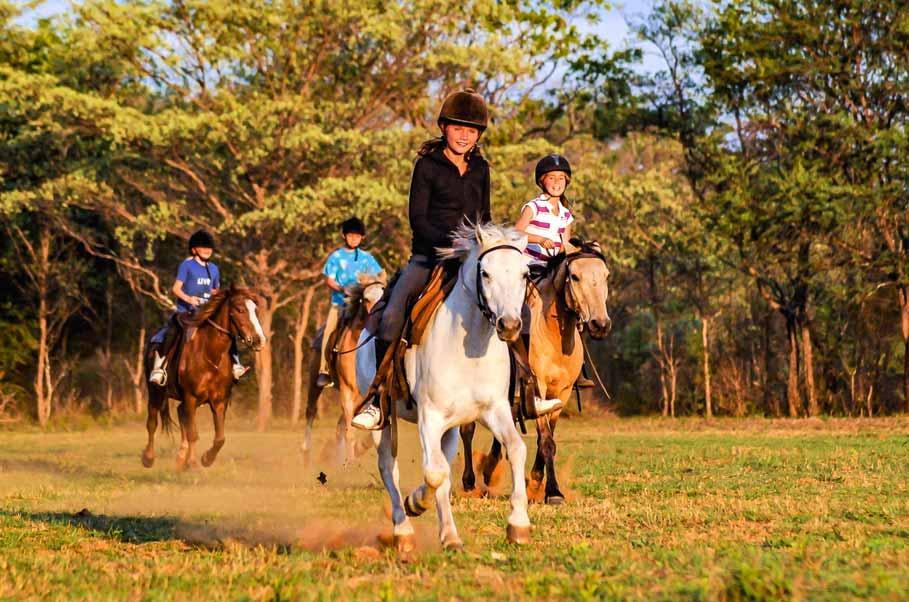
51
South Africa - Waterberg.
Choosing the right family ride
The right choice for a family riding holiday is based on a mixture of length of stay, budget, riding ability, preferred accommodation, mobile trail or static ride, and whether you require options for non-riders.
Some advice:
• In all scenarios, if you wish to get the family together then the speed of the ride is likely to be slower - the riding is always adapted to the skills of the weakest rider.
• For a family with children less than 8 years old, we recommend staying in either one or two lodges and riding out from there each day.
• For small children the days have to be kept very busy whilst still allowing time for them to rest (nap/read/play quiet games) either before or after their riding.
• Plan some games for the quiet times - a football, a kite, drawing pencils etc.
• If your children are over 8 years old, then you may be able to join some mobile trails under canvas, for example a ger
• camp in Mongolia, where it is possible to have a tent which
sleeps four, so that the young feel safe and the adults can be reassured.
• The menus are adapted for children and there are some little treats provided (chips, Nutella, pancakes). Mealtimes are planned around the children or separate mealtimes are provided.
• From 12 years old and upwards, particularly if the children are active, independent and good riders, they can participate in many horseback trails which are not specifically aimed at “Families”. Under 18’s must always be accompanied by an adult.
• Non-riders are welcome and may be able to join the riders on a camel, walking, on a mountain bike or in a vehicle.
52
Did you know
The fifth pace of the Icelandic horse
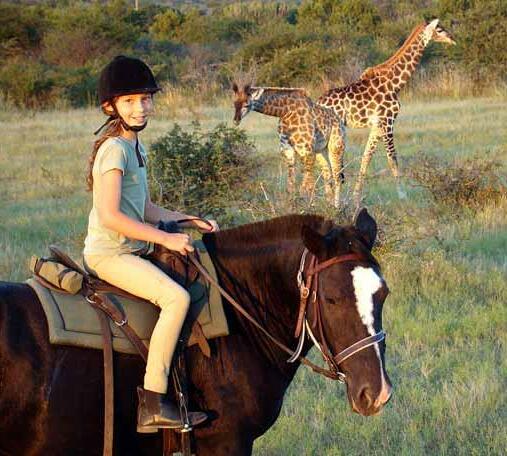
The tölt is a natural, extended walking paceclear, rhythmical and with four equal beats it can vary in speed from slow (walking pace) to fast (cantering pace). It has a spectacular appearance and looks staccato but in reality it is very comfortable, to the point that a rider can carry a glass of water without spilling a drop. It is a comfortable pace for children to learn on the trail.
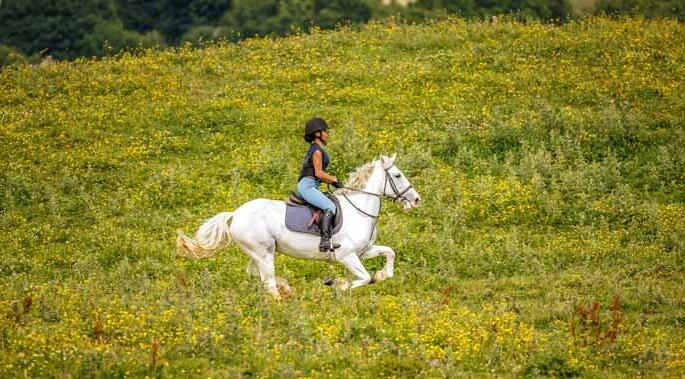
53
Ireland - Cross-country jumping.
South AfricaWaterberg plateau.
Galloping in the dust amongst zebra, I am half a man, half a horse, for a thrilling and amazing race, half aware of this unique sensation. Being on horseback in the bush is to be as a centaur in an infinite original landscape; it is to feel the strength and brutality of wildlife; it is to marvel at the harmony of the early morning; it is a primitive relation to nature. It has to be known once in a riders life.
 Chris Leservoisier, Rider.
Chris Leservoisier, Rider.
54
Botswana - Kalahari, Makgadikgadi Pan.
Encounter wild African animals in South Africa, Botswana, Kenya, Tanzania and Namibia, where a horseback safari usually also offers a high standard of comfort! Whether in lodges or fly camps, you will feel the atmosphere of “Out of Africa”.
Horseback Safari
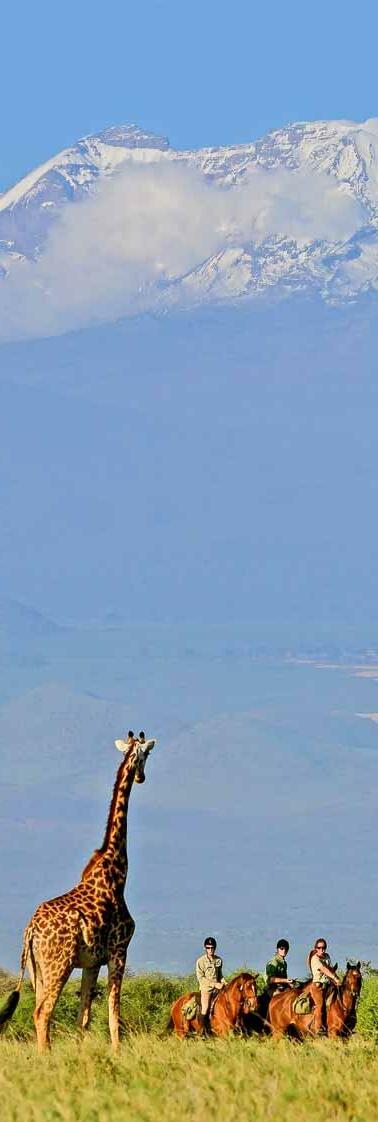
55
Read more…

“With the crisp sand of the Namib under the hooves of our brave horses, and the big open skies of Africa over our heads, we gear up for an exhilarating canter... Flying across the Namib is freedom at its finest.”

56
Namibia - A rare giraffe sighting in the Naukluft desert.
A Horseback Safari
A horseback safari is either mobile with fly camps such as in “Out of Africa” which move each day or every other day; or daily rides from very nice lodges or comfortable static bush camps.
Whichever kind of safari you choose, the daily pace is usually the same. You are woken early in the morning with tea or coffee brought to your tent. Then, after a light breakfast, you ride for 34 hours, alternating canters with walking whilst viewing the game. After lunch there is time for a rest and siesta until teatime, when you head out for a shorter ride during the subtle evening light.
Safaris in open spaces with lions and elephants are usually

limited to groups of 8 or 10 riders and are always accompanied by an armed lead guide. The second guide (back up guide) brings up the rear and becomes the head guide in case of danger, such as an elephant charge. You will be impressed by the skills of your guides - they are very good riders and have a large knowledge of the fauna, the flora and the environment around you. Most of them are English speakers and first aid trained.
Your horses are prepared by the local team so you can completely relax.
Riding helmets are usually compulsory and we recommend taking your own.
57
On the blog…

“The most magical and uplifting moment for me was to gallop alongside a group of giraffe, It’s difficult to not say too much as there are so many wonderful surprises that await you, but my permanent smile said it all. Wading through floodwaters, cantering through the water and galloping with the game running alongside, these are memories that I will treasure forever.”

58
Botswana - Extraordinary wildlife encounters in the Okavango Delta.
Kenya - Masai Mara.


Did you know
One of the main differences between a predator and its prey, apart from the diet, is the placement of its eyes. The predator has its eyes in front of its head, watching his prey, ready to hunt. The eyes of the prey are on each side of its head, watching behind or in front, alert to a potential danger. It is a privilege that the horse, as a prey animal, allows a predator (a human) to ride upon his back.
59
Tanzania - Kilimanjaro Elephant safari.
Did you know
The wild horse of Namibia is a breed originating from the horses (Kap-Boerperds, Hackneys and Trakehners) of Germanic and South African forces, which were abandoned during the First World War. Some 200 horses survived in the area of Garub - almost desert, listed as a nature reserve and with access strictly forbidden after the discovery of diamonds close to Lüderitz in 1908. They are able to endure extreme temperatures (as much as 70°c in December down to -5°c in June), and tolerate frequent strong winds up to 140 km/h. Their size reduced to assist them in this harsh environment. The history of these horses is mentioned in the book and film “Running free”.
Safari Horse
A good safari horse has very particular skills because it lives and moves in an environment where it can be prey. In the bush, its relationship with man protects him from predators, in particular lions. He has to be tough, calm and very energetic, balanced, resilient and used to meeting the large wild animals: elephants, giraffes, cats etc. Most of these horses originate from numerous cross breeds between horses imported from different European Countries and more recently from Argentina or USA with local horses such as Basuto, Abyssinien, Somalian and Boerperds. Their resiliance in the bush is bred into them and they develop resistances to local diseases.
The Breeds:
In East Africa, the horses originate from Arabia-Somalia, English thoroughbreds, Boerperds, Somalian ponies and Namibian Warmbloods often crossed with Spanish blood and Trakehner. Often used to play Polo, they are easy to handle and tough.
In Southern Africa, horses are mainly Namibian, Hanoverian, Trakehner, Haflinger, AngloArab, Barb-Arab, English Thoroughbred, Appaloosa, Shire, Boerperds and Warmbloods - all very energetic, tough and surefooted. There are even two Percherons in the Okavango Delta.
In general, these horses can carry riders of 85-90kg maximum, but this depends on the ability of the rider. On some safaris there are horses which can carry heavier riders.
Namibia - Damaraland.

60
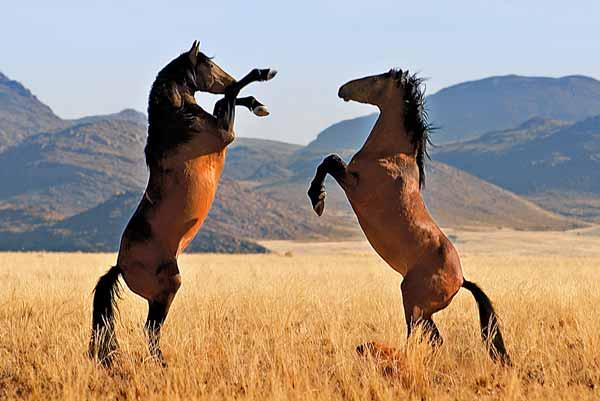

61
NamibiaGarub desert, wild horses.
Tanzania - Mount Meru to Kilimanjaro.
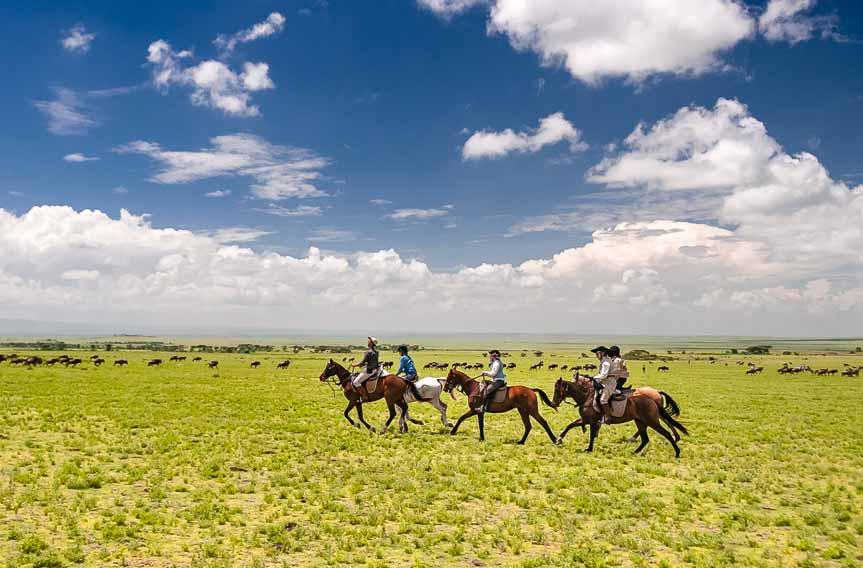
62
Tanzania - Seregenti, the Great Wildebeest Migration.
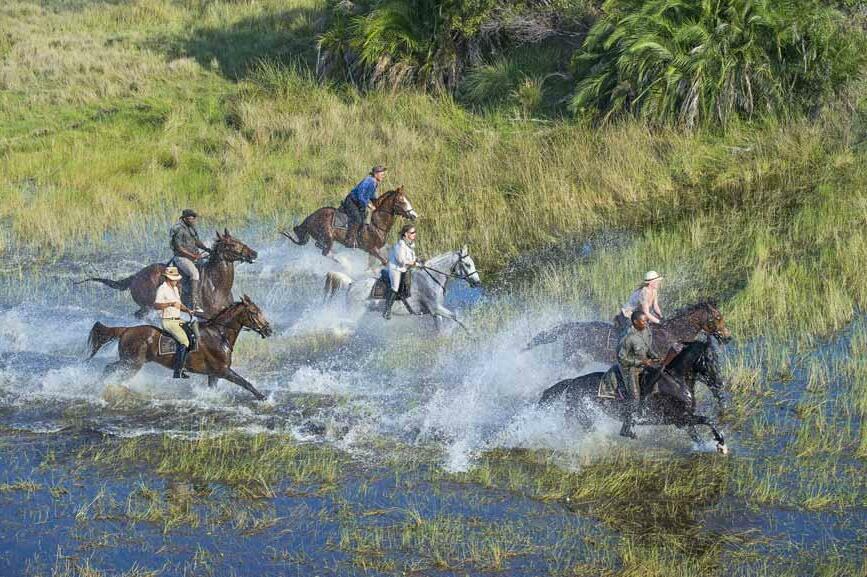
63
Botswana - The Okavango Delta.
South AfricaWild Coast.
Choosing the right horseback safari
The right choice for a safari is based on a mix between: budget, riding experience, required comfort, duration, mobile or static, open to non-riders/family and prior safari experience.
• The average duration of a safari is generally 6 to 7 days on horseback, so a total of 9 to 10 travelling days. It is possible to extend your holiday to Mozambique, Zanzibar, Victoria Falls, Cape Town etc.
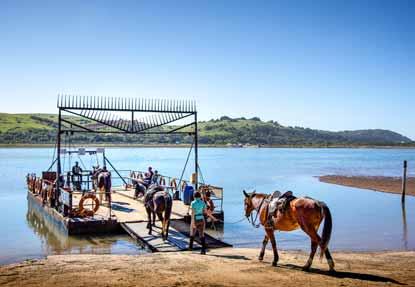
• A horseback safari budget varies from £1,100 to £5,200 excluding international flights.
• The requested riding experience is often linked to the wildlife present. Therefore, the presence of
lions and elephants requires a high standard of riding in order to react quickly. Conversely, a horseback safari from a lodge on a private fenced reserve without predators, is open to all equestrian levels. A mobile safari is usually limited to competent riders.
• Non-riders are welcome on many safaris. They will participate in the unique experience of a safari on foot, by boat, mountain bike or vehicle.
• Riding and walking safaris suit those who wish to learn about the different fauna and ecosystems they will encounter - game drives are usually possible as well.
• Some riding safaris have horses which are suitable for different levels and are also accessible for riding families. See also our chapter for Families.
64
South AfricaWaterberg plateau.
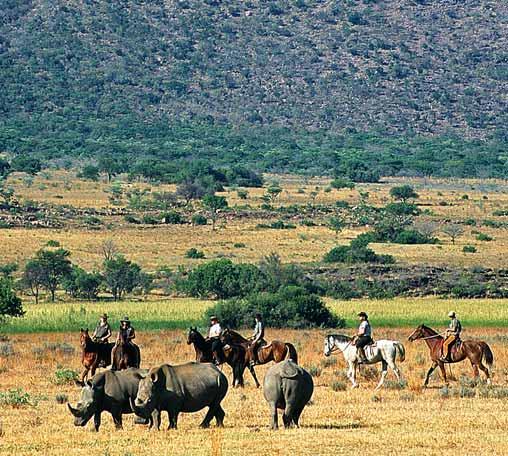
Botswana - Tuli Block.

65
Be a cowboy of the four seasons, on a saddle behind the back of cows, in the dust, the mud, the snow, the wind and under the sun with an unlimited horizon. Gallop, relax and trust your horse, an old working companion… and at night by the fire, a shooting star, a horse snort and a touch of melancholy.
Joanne Verth, apprentice cow-girl.

66
A well trained working horse; a herd of cows, sheep or horses; a wild immense landscape and a way of life - all combine to offer the chance to become a gaucho, cowboy, wrangler, charro, guardian, chagra, vaquero… There is a world full of equestrian ranching traditions to experience.
Ranch & Cattle Drive

67

68
Argentina - Rounding up cattle at El Boqueron.
Cattle drives and working a herd

In Iceland, North America or Patagonia… everywhere the horse is necessary for farmers, we propose a selection of holidays which centre around the work of ranchers and cattle drives. These holidays speak to riders who are looking for real and authentic experiences and wish to be completely involved in the work of a ranch with a herd of horses, cows or sheep. It is about rounding up and moving on a herd to another pasture, to sort through the stock and work with lasso to brand, castrate or vaccinate. The daily activities are determined by the needs of the farmer and the season.
For these livestock farms, which have often been owned by the same family for several generations, the welcoming of riders is a complementary economic activity. Do not wait for a tourist guide but set out to discover true locals: sometimes reserved, even unassuming, or authoritarian, gruff or impertinent, and with strong accents, they are always passionate! Go to meet them
peacefully, to talk about their horses and their herds, to learn the lightness of a hand or the anticipation of herd reactions - it will open the door to an old world for you. The rancher will also help you with the choice of your horsethey have an intuitive perception which almost immediately assesses your abilities and finds you the perfect companion.
69
USA - Colorado, Chico Basin ranch.
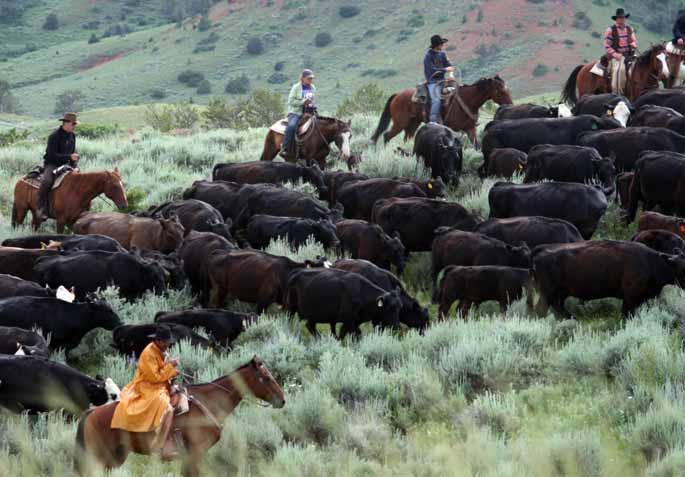
USA - Montana.
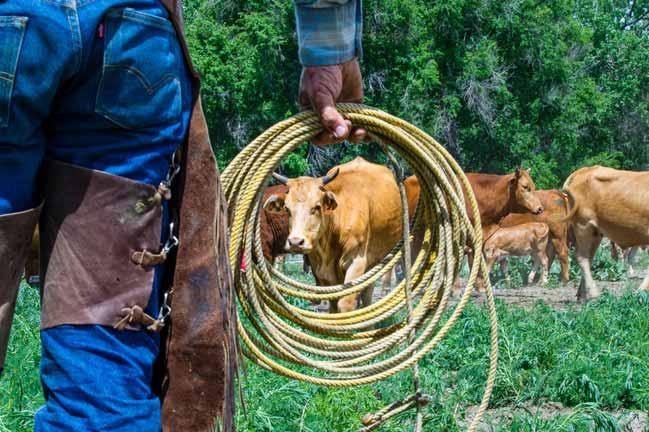
70
Working horse
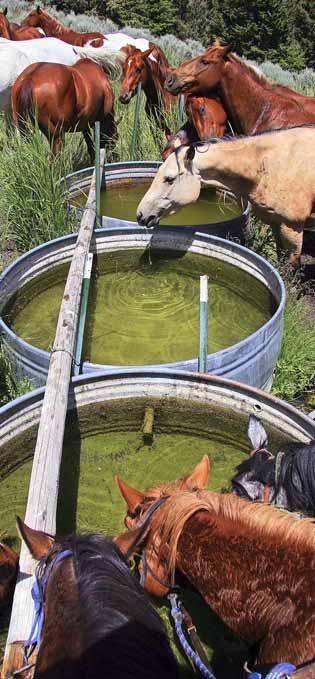
Ranching and the necessities of extensive cattle farming, such as locating large herds on huge territories in order to look after, treat, select, round up and move on is intense work and requires tough, multipurpose horses, which have to be trustworthy companions for their riders. Patient training leads to a perfect understanding between the rider and his mount, who work together as one.
The working horse often has a natural "flair for cattle" and during the cattle cutting or lassoing, he will know how best to place himself so as to help the cowboy with his task. He will know how to move slowly in a herd to isolate a cow and its calf, listening to his rider who guides him with his seat, legs or hands; and then to burst forth in a furious gallop to retrieve the calf that has strayed from the herd.
These horses are famous for their exceptional disposition, which combines good agility with spirit and being easy to handle, making them unique working
partners. Even though they are tough, the requirements of the work can mean that you ride 2 to 3 different horses each day.
71
Read more…

“You are riding. You are flying. You sit slightly back, feet a bit forward and legs tight, with light contact on your horse’s mouth. You hear the hoofbeats of 100 horses all around you, some under saddle, some running loose. Your horse, ears forward, gaze intent, has entered ‘the tölt zone’.”

72
Iceland - Landmannaafréttur sheep round-up.
The Breeds:
The Icelandic horse is a unique breed which has been isolated for 930 years and still demonstrates two extra pacesthe tölt and flying pace. His energy, toughness and surefootedness make him a "catch-all" horse, ideal for rounding up sheep. The Camargue is inseparable from his “gardian” for looking after and sorting a herd of bulls. The “Camarguais” is a lively, agile, robust and very tough horse. Gifted with infallible instinct and large feet, he is perfectly adapted to his subaquatic environment.
The South American Criollos are renowned for being particularly frugal, healthy, robust and tough. Capable of carrying very heavy weights for long distances and over all kinds of ground, they have an autonomous and independent nature.

The North American Quarter Horse is used for all ranch work and is therefore very good at, and of course he is also presented for, Western riding disciplines: reining, western pleasure, cattle cutting etc. His agility, balance and speed are much appreciated.
Did you know
A quarter of a mile
The origin of the Quarter Horse breed goes back to the colonization of North America, when colonists were looking for a horse which was fast over short distances, because the town races did not exceed one quarter of a mile. They crossed their horses from England with the descendants of Spanish horses, to breed an explosively fast horse over short distances. More than 150 years later, a Virginian breeder, John Randolph, imported a Thoroughbred to improve the capacity of the breed to run long distances. At this time, with the conquest of the American West, he introduced Mississippi Mustangs to the mix, which gave him vigour and toughness, creating the Quarter Horse we know today.
ArgentinaGauchos at work.
73
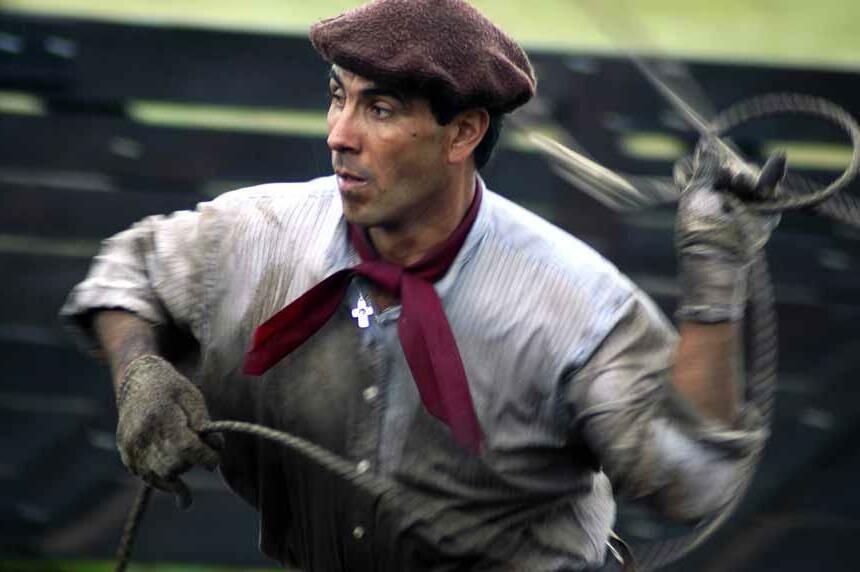
74
Argentina - Gaucho in action.
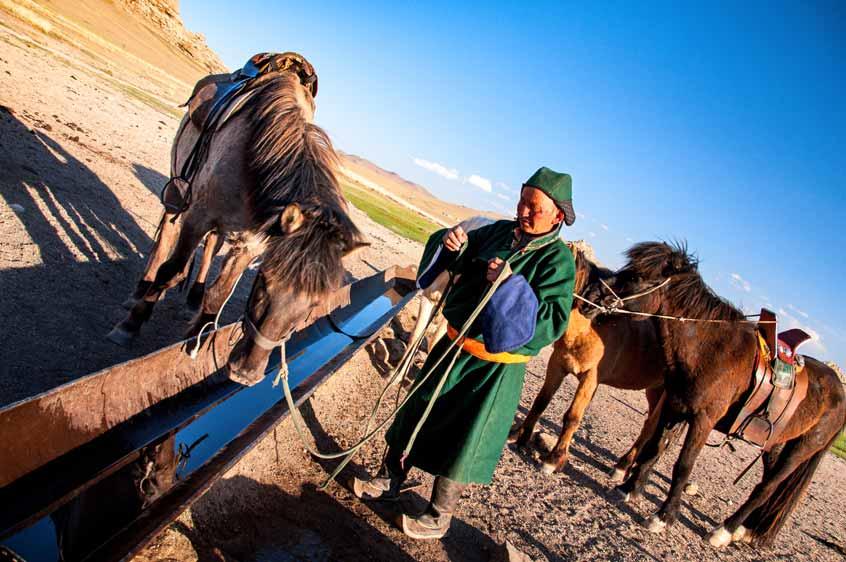
75
Mongolia - Somewhere in the Gobi desert, Batbayar checks the sheep trough.
Choosing the right holiday
The right choice is based on a mix between: budget; riding experience; required comfort; duration; mobile or static and prior experiences.
• The average duration of ranching holidays is generally 6 to 8 days on horseback, so a total of 10 to 11 travelling days, depending on the destination. In the USA there are many options to extend your trip to include Yellowstone or Grand Teton National Park or to visit rodeos etc.
• For this kind of trip the budget varies from £800 to £3000 excluding flights.
• Non-riders are welcomed by some ranches, where it is possible to learn to ride or to go fly fishing, walking, mountain biking, sailing, canoeing etc.
The different possibilities include:
• The driving of horses, sheep or cow herds in order to move pasture, are recommended for competent riders only, who are physically fit. They run on only a few dates each year and you need to book in advance.
• Working ranches which are devoted to working with cattle, generally offers accommodation which is quite simple - from a local house to a prospectors tent. These ranches are recommended for good riders who are motivated to work with their horse (6-10 hours riding each day).
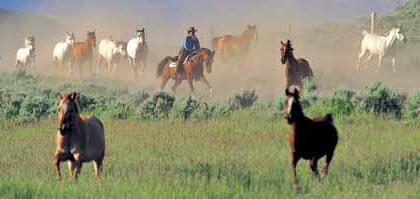
• Ranch stays which are more multipurpose and open to everyone: learn to ride, take part in non-riding activities and spend time with your family. The accommodation can range from simple bed and breakfast in an estancia to a cozy log cabin.
• Specific dates around an equestrian festival or a training course: ethology, reining, cutting, barrel racing… See also our chapter about Instruction.
76
USA - Wyoming.
Did you know Wrangler?
Wranglers are cowboys who take care of the spare horses waiting at the back during large cattle drives. Some drives with c. 3,000 head of cattle required 10 to 15 cowboys, riding 12 hours per day and regularly changing horses, therefore a herd of 50 to 70 horses were needed. The “wranglers” kept the herd together and assured their protection against thieves, because no cattle drive was possible without the horse or its cowboy!!
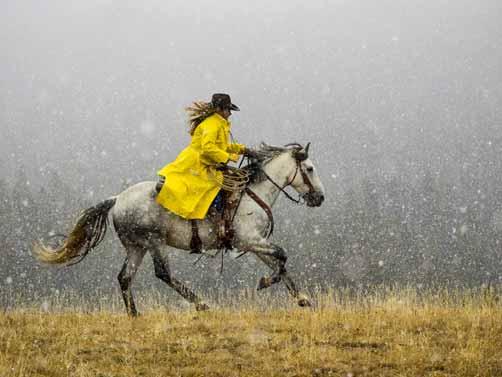
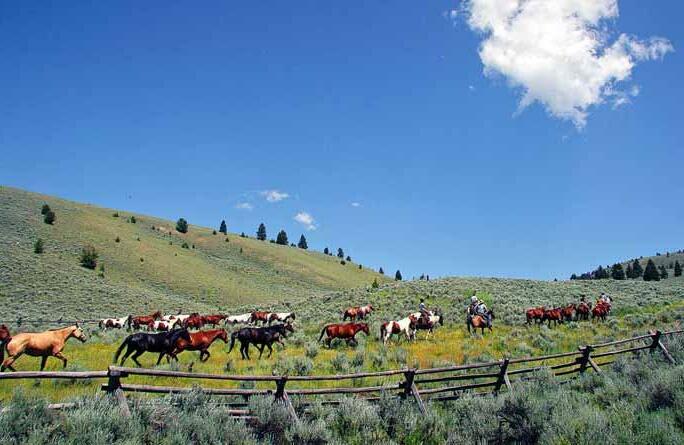
77
Usa - Wyoming, Hide Out
USA - Idaho.
Between Borana Lodge and Sosian lies the Laikipia plateau, at the foot of Mount Kenya. In this elegant environment we were welcomed and offered the liberty of choice: horseback safari, walking safaris, following the herds in a vehicle, strolling, spending a night in the bush… everything was possible and real. We lived our dream…
Honeymoon couple, one of whom was a rider.

78
A riding holiday based at a centralised accommodation, with rides in different directions each day which can be adapted to differing riding levels and to your wishes. You can unpack and relax, knowing you return to the same place each night and even sit out a day and rest if you prefer.
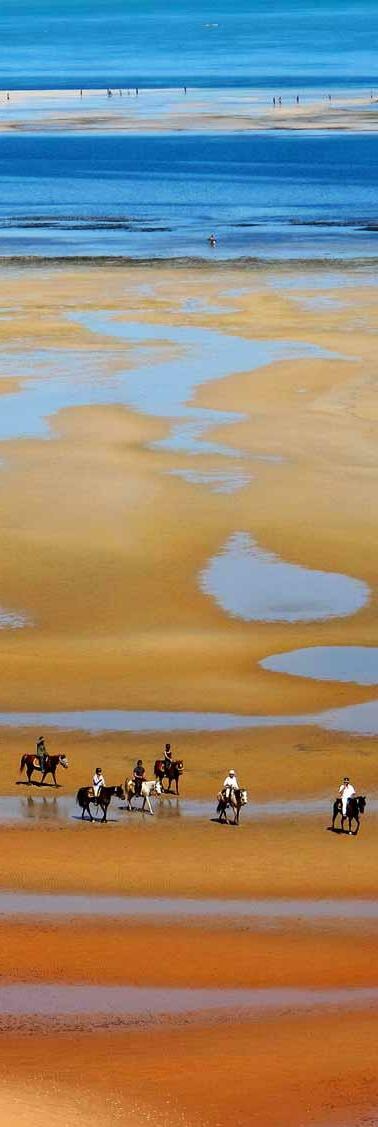
Riding Holidays
79

80
Brazil - Fazenda stay in the Pantanal.
Spirit of the holiday
A centre based riding holiday offers comfort, a variety of activities for riders and nonriders, flexibility on length of stay and options for different riding abilities. It is an opportunity to share a horseback holiday with your family, as a couple or amongst friends, without worrying whether the non-riders will get bored. Wherever in the world you choose, a centre-based riding holiday is the ideal solution for a personalized trip because it allows you the possibility to combine several lodges which can offer quality horses and guides. These riding holidays are initially selected according to the quality of available horses, the quality of the guiding and
the “riding” mind of the owners. If the owner of a hotel which proposes horseback trails is not a rider himself, then he will not understand the needs of the riders. So it is the selection of the guide and his horses first and then the accommodation. In most cases, the lodges selected have a small guest capacity; the meals are good and generous and there is a family atmosphere. Often nestled in areas of beautiful scenery which is favourable for long trails on horseback, they permit many different routes to keep you interested for several days. And when there are only a few good rides from each lodge, then your itinerary can include two to three different lodges in the area.
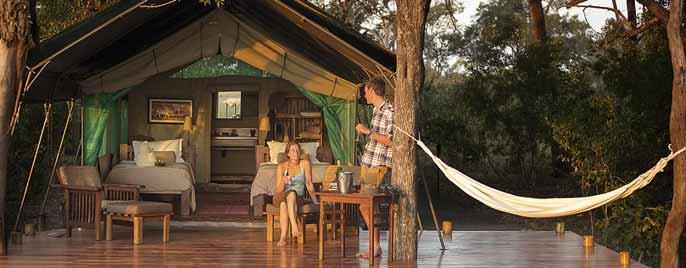
81
BotswanaOkavango Delta, Macatoo Camp.
Did you know
Descendants of the Magyar warriors of Hungary, the Csikos (literally “horse herd keepers”) are the last representatives of the historical riding tribes of Central Europe. To move the herds of horses, they use a whip which is 6 meters long and their saddle has no girth - just a surcingle!
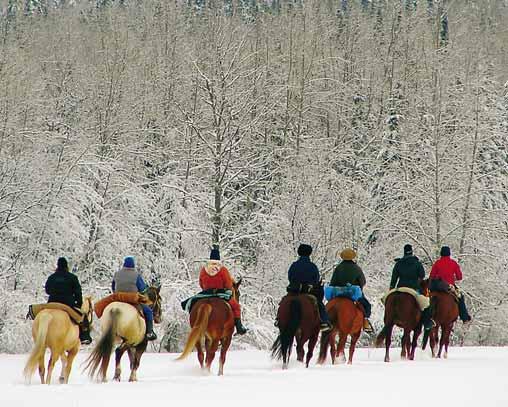
Canada - Quebec.
Portugal - Azores, Faial Island.
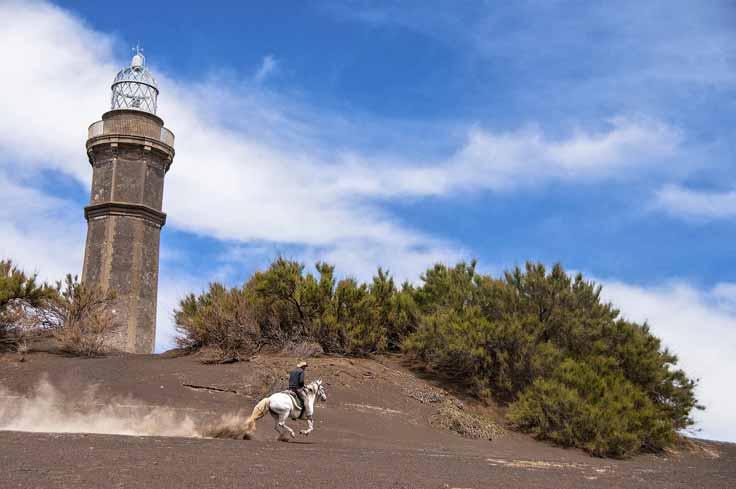
Read more…

“Working cattle, riding beautiful Criollos across the wide-open pampa, or trying my hand at a friendly game of polo... Life at Los Potreros is a life worth living”
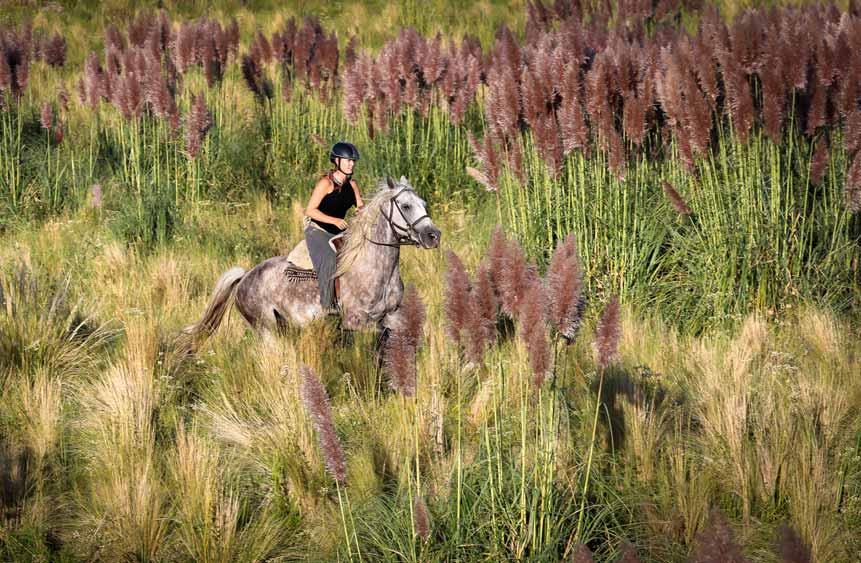
83
Argentina - Estancia los Potreros.
Did you know
Stallion or mare?
In North African and Middle Eastern countries such as Morocco, it is traditional to ride only stallions, and the mares are devoted to breeding.

Stallions are rarely castrated. Though the Islamic teachings and the Qur’an are ambiguous on this topic, the prophet Muhammad was said to “prefer mares, because their belly is a treasure and their back honours your seat”.
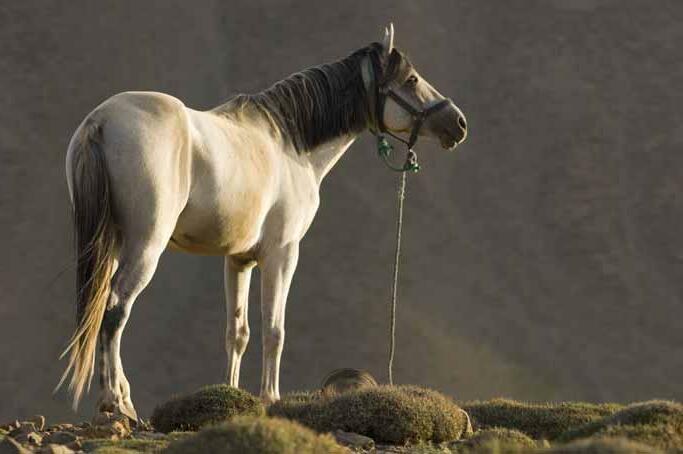
Morocco - Atlas, Barb Horse.
HungaryPuszta Plains Trail.
84
Choosing the right holiday
The right choice depends on a mixture between the length of stay, your budget, riding level and the standard of comfort you prefer. Also, if you have non-riders in your group or wish to relax and the number and type of alternative activities on offer.
Horses
The stable of horses are often varied to cater for different riding levels and also so that they can be suitable for riding families. See also our section on Families.

Some breeds
The Hungarian warmblood, was first developed at the Mezohegyes State Stud in Hungary. The stud crossed native Hungarian horses such as Nonius, Kisber Felver, Gidran and Furioso to produce the warmblood; these native breeds are also present in the Holsteiner, Hanoverian and Dutch warmblood. The Hungarian warmblood stands 16 - 17hh and is lighter and more elegant than some of its heavier warmblood predecessors.
The Barb, or Berber horse, is a pure breed and native from the Maghreb region (Morocco, Tunisia etc). Historically it was used for parades, work and, of course, war. Over 2000 years ago the Romans called him the “Horse of Barbarity”. An Arabian
song proudly describes him with this concise speech: “he can be hungry, he can be thirsty, he can be cold, he can be hot, but never is he tired”. His exceptional qualities made him the preferred mount for dressage in numerous European royal courts from the 14th century onwards. The Napoleonic army also used this horse and the French regiment of Spahis consisted entirely of Barb horses. Of medium size, calm, sweet, balanced, courageous and tireless, he is the perfect trail horse.
85
HungaryMagyar rider.
Mozambique - Cantering in the Indian Ocean.
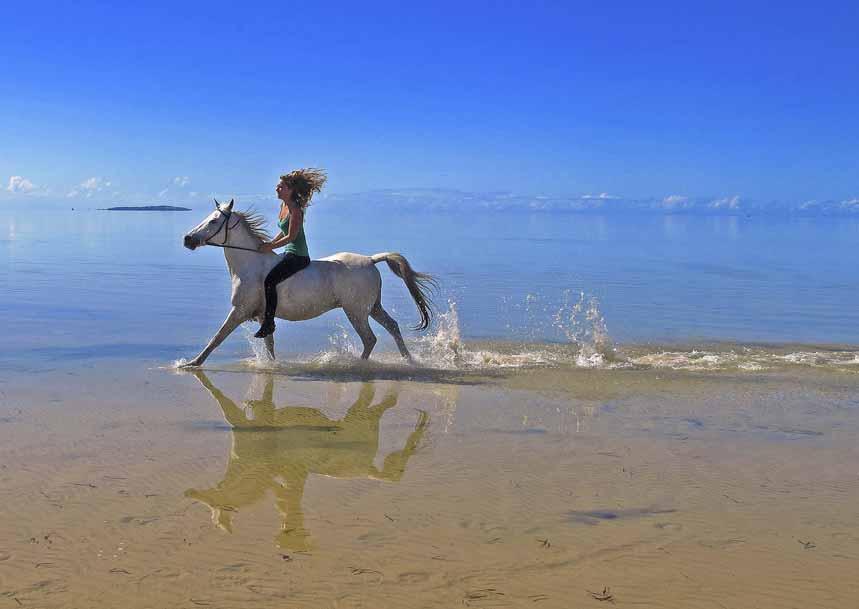
86

87
Turkey - The wonders of Cappadocia.
Just for a moment, it all comes togetheryou find the right buttons and everything falls into place. You and your horse are as one, in harmony, dancing to a symphony only you can hear. To start with it’s fleeting; one stride, two strides; then lost. But once you feel it, you’re hooked and a lifetime’s passion has begun…
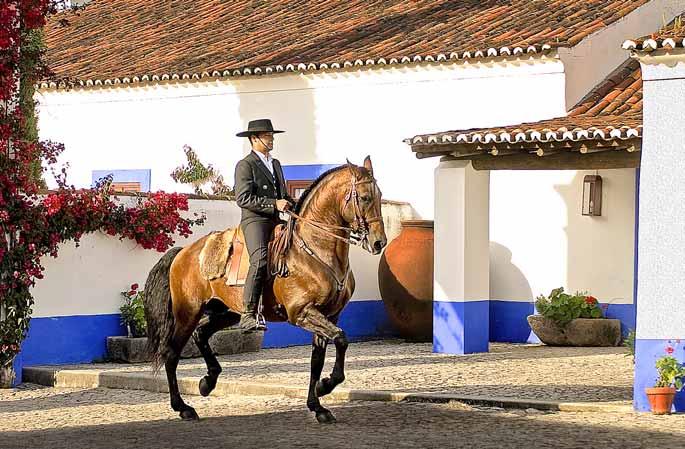
88
Learn, listen, understand, feel and tirelessly follow in search of lightness and discretion of the aids.

89 Instruction
Training & clinic events
Occasionally, we propose training and “clinic events” with instructors or specialists recognized within their discipline. If you wish to be kept regularly informed of these special dates, please contact the team at Equus Journeys and point our your interest: info@equusjourneys.com
Learn
In riding, we are eternal apprentices and always learning… Whichever style of riding you choose, every progression you make reveals another set of skills to learn and so you go tirelessly back to work. In one week, a good instructor and well-schooled horse can help you to improve. Some of our instructors, such as Rafael Sotto, possess a very high equestrian level and the talent to impart that knowledge. Together with schoolmaster horses you can learn to feel if the movements you have requested are right and then take that feeling home. The horses themselves are our greatest teachers!
Classical dressage
The equestrian schools are chosen first for the quality of their horses and of their instruction. Then follows the factors of comfort and the charm of the accommodation and the accessibility.
For instruction in Portugal and Spain, the highly trained horses are PRE Andalucian or Lusitano. The Lusitano is the result of selecting for cattle work and arena work, whereas the PRE Andalucian was bred for cavalry and bull fighting. In Italy, your horse choice is more varied with breeds including Thoroughbreds and Arabs.
Endurance
To succeed in this discipline is to respect the equestrian adage: “fair and softly goes far in a day”. For this reason, the rider has to “feel” his horse, how to adapt his pace to the ground, how to be light in the saddle… And of course, listen to his horse and look after it. It is difficult to determine a specific model of endurance horse even if the Arabian breed gathers the most number of necessary qualities. We also find a lot of the talents of the Arabian in the crossbreeds: Anglo-Arabs and Barb Arabs.
90
did you know
Nuno Oliveira (1925-1989), was a Portuguese riding instructor, considered as the most important master of equestrian art in the 20th century. Fuelled by a love of equestrian culture and opera music, he approached riding as a true art and devoted his time to learning and teaching lightness and the love of the horse through his clinics and writing. Hypersensitive, quick-tempered, generous, independent and a genius he is still revered amongst lovers of Classical Dressage.
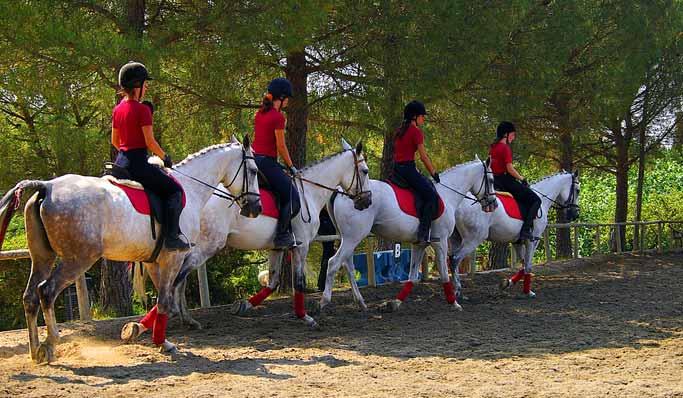
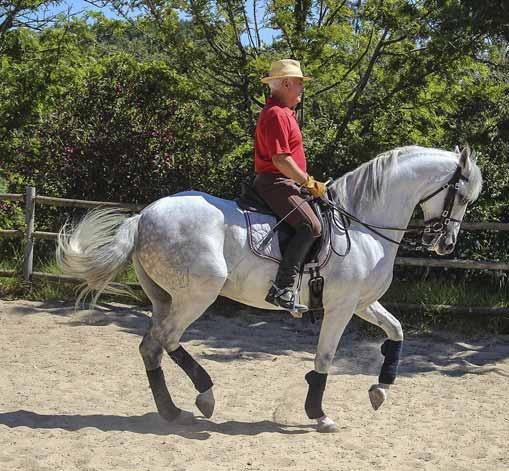
91
Portugal - Alcainca.
Italy - Tuscany.
Dressage holidays

Riding one of Epona's beautiful PRE schoolmasters is the experience of a lifetime for many dressage riders. You cannot fail to learn something or have a “light bulb” moment...

92
Epona - High school dressage & Intensive training.
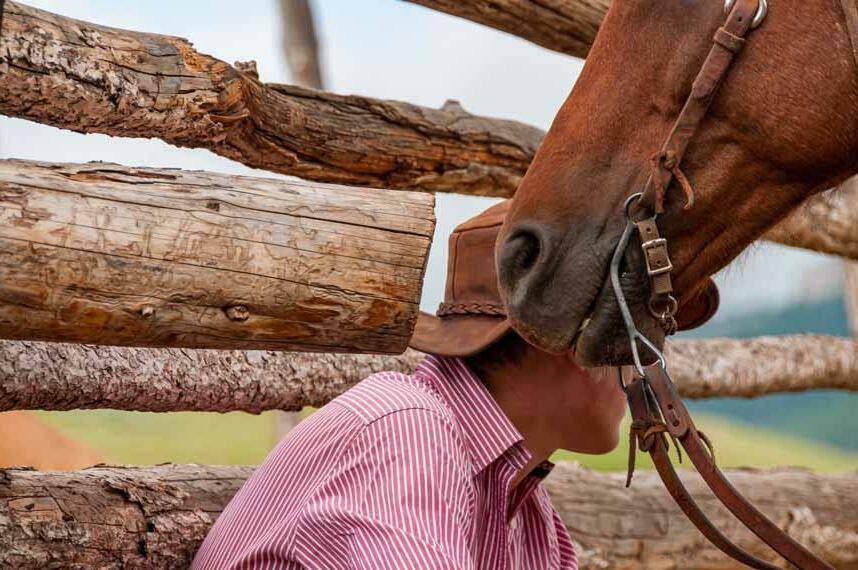
93
United States, Montana - The horse whisperer... or perhaps the other way around?
Western riding
Recently recognized by the international authorities, Western riding is represented at the World Equestrian Games through reining. For reining, the rider has to control his horse with accurate precision to perform circles, pirouettes and stops, all while keeping his reins in one hand. This riding developed through the skills required by the daily work of cowboys and the necessity for perfectly trained horses. The cowboys, after finishing their
Natural Horsemanship

Natural Horsemanship is a method of training horses based on equine ethology, and aims to interact with the horse in a way which takes the psychology and natural instincts of the animal into account. Its North American origins are most probably linked to western riding, which requires absolute control over the horse, with the condition that the rider
work, liked to measure their equestrian ability and the quality of their horses and so they invented numerous events inspired by their daily life, such as barrel racing, roping (capturing a calf with a lasso) and, of course, the rodeo. The horses used most frequently for western riding are the working breeds - the Quarter Horse dominates the discipline, but also the Appaloosa, Paint, Mustang and Criollo.
must consider his horse as a partner and an obedient collaborator, basing the relationship exclusively on trust. This relationship leads to complete harmony between the rider and his mount. Natural horsemanship is practiced on all breeds of horse and its theories are recommended to all riders.
94
Did you know
The oldest team sport in the world!
The first evidence of the game of Polo appeared in Persia some 2,500 years ago. The sport spread to Constantinople and from there to Turkmenistan, Tibet, China and Japan. In the 12th century, Gengis Khan conquered Iran and Afghanistan and brought Polo back with him to practice with his warriors. The game became an essential teaching tool: it tests the merit of a man and reinforces his personality. Polo teaches him agility on horseback, an appreciation of speed, of the intensity of battle and a decisive mind.
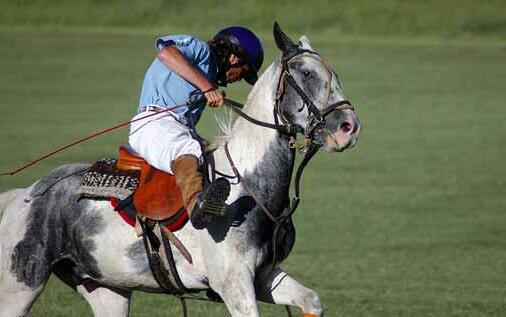
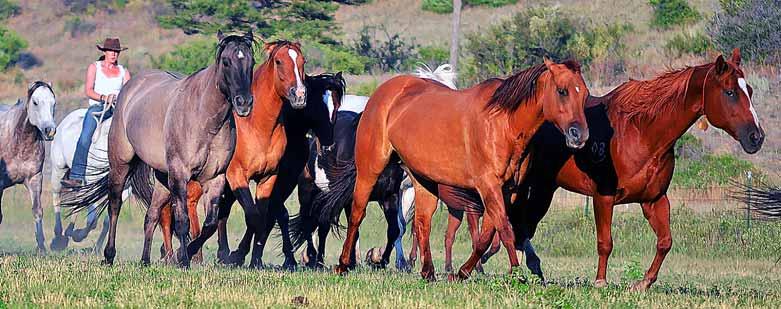
Z.
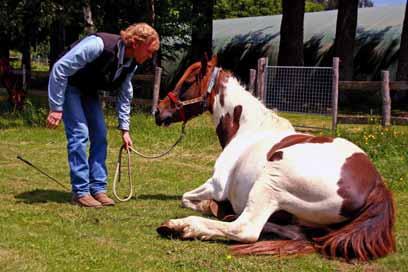
95
ArgentinaLos Potreros.
USAMontana, Rocking
Artwork: Marc Chilliet.
Thanks to the photographers: Anne Mariage, Christophe Leservoisier, Sophie de Seynes, Line Turin, Annie Vorac, Christophe Raylat, Frédéric Gomez, John Sobey, Louise Carelsen, Sarah Jane, Betty Garcia, Kevin Begg (93), Pat Retzlaff), Fransisco Mayer, Martin Mallaret, M. Binnendick, Slawik, Ant Barber, Laura Dowinton, Astrid Harrisson, Eduardo Finkel, Emilie Chaix, Joanna Westermark, Fulvio Cinquini, Céline Frers, Family Wirth, David Foot, Franck Molina, Christophe Migeon, Laurent Girard, Cathy Berard, Elisabeth Stegmaier.
This horseback travel guide is purely indicative and does not guarantee the availability of rides or services. It is accurate at the time of going to print, but for up-to-date information please check our website www.equus-journeys.com or call our office.
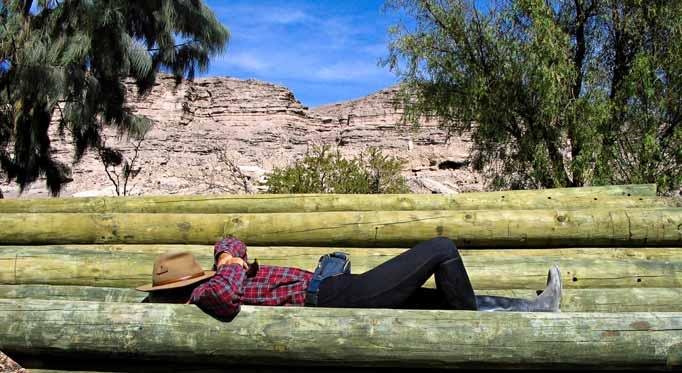
Any payments you make to Equus Journeys are 100% financially protected. Equus Journeys has subscribed to a financial guarantee for the entirety of the sums perceived by Equus Journeys with Atradius, 44 avenue G.-Pompidou 92596 Levallois Perret Cedex - Contract n°375442.
Hiscox is the civil and professional liability insurer with a guarantee up to 8.000.000 €, 19 rue LouisLegrand - 75002 PARIS - Contract n° HA RCP0106121

EQUUS JOURNEYS is a brand of Cheval d’Aventure Ltd company € 214,286 capital - Registered with Atout France IM069100050
Registration number: RCS 518 925 318 - VAT number: FR74518925318
Registered address: 2, rue Vaubecour - 69002 Lyon - France
Correspondence address: 14a Forest Gate - Pewsham - Chippenham - Wiltshire - SN15 3RS - United Kingdom
Ar Th 13 (31 (55 Pat (52 (71 cov 44 Ste Th or che

96
Chili - Atacama Desert, after the ride… siesta!
A Sahara duneMy horse gallops away

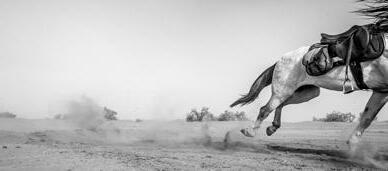

So, I walk alone
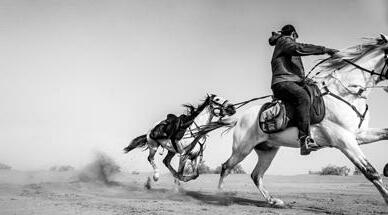
Horseback

www.equus-journeys.com
Travel Guide Tel: +44 (0) 1905 388977 | info@equus-journeys.com This guide is an invitation to ride around the world and an illustration of some of the different trips that are possible. On the Equus Journeys website you will find all of our rides, together with the detailed up-to-date itineraries; and a host of interesting information and articles about the different breeds of horses and riding traditions you might encounter.



























 India - Ladakh, Little Tibet.
India - Ladakh, Little Tibet.













































 Chris Leservoisier, Rider.
Chris Leservoisier, Rider.




























































